Take Me to the Recipes
Bosnia and Herzegovina, nestled in the heart of the Balkans, offers a rich tapestry of history, culture, and, notably, delectable Bosnian food cuisine. The country’s diverse landscapes, from rolling hills to stunning mountains, set the stage for an exploration of flavors that reflect the nation’s tumultuous past and vibrant present.
Located in Southeast Europe, Bosnia and Herzegovina boasts a continental climate with hot summers and cold winters. Its scenic landscapes are adorned with dense forests, pristine rivers, and charming villages. With simple yet flavorful ingredients, Bosnian Food cuisine encapsulates the warmth and hospitality for which Bosnia and Herzegovina is renowned.
While industrial activities contribute to the economy, the essence of the nation lies in its resilient people and their diverse traditions. With a population that mirrors its multicultural history, Bosnia and Herzegovina is a cultural mosaic waiting to be explored.
Read on to uncover the savory secrets of Bosnia’s culinary heritage and its impact on the world of gastronomy.
Take Me to the Recipes
Bosnia and Herzegovina Food – Key Takeaways
- Cultural Fusion: Bosnia and Herzegovina’s cuisine reflects a unique blend of Ottoman, Austro-Hungarian, and Balkan influences.
- Diverse Flavors: From hearty meat dishes to delicate pastries, the food captures the essence of the nation’s varied history.
- Traditional Delights: Explore iconic dishes like Cevapi, Burek, and Begova čorba that have stood the test of time.
- Influences from History: Understand how historical events shaped the country’s culinary traditions.
- Climate and Geography: Discover how the region’s climate and geography influence the ingredients and cooking techniques.
- Health Implications: Explore the health benefits and considerations associated with Bosnian cuisine.
- National Dish: Uncover the significance and preparation of Bosnia’s revered national dish.
Where is Bosna and Herzegovina?

Bosnia and Herzegovina is in Southeast Europe, situated on the Balkan Peninsula. It borders Serbia to the east, Montenegro to the southeast, and Croatia to the north and southwest.

Index to article
- Take Me to the Recipes
- More Articles for Your Pleasure
- 10 Fascinating Facts about Bosnia and Herzegovina
- Bosnia and Herzegovina History and the Effect on the Cuisine
- How Bosnia and Herzegovina’s Climate and Geography Influences Food
- Understanding the Essence of Bosnian Food Recipes
- Traditional Bosnian Food
- What Are the Health Implications of Bosnian Cuisine
- Bosnia’s National Dish
- Exploring Bosnia Ingredients: The Flavors of Bosnia Cuisine
- Bosnian Recipes to Try at Home
- Conclusion
- Commonly Asked Questions
Take Me to the Recipes
More Articles for Your Pleasure
- North and South American Cuisine – A Culinary Expedition
- European Cuisine: Savor the Continent’s Best Culinary Secrets!
- African Cuisine: Discover the Bold Flavors & Global Charm!
- Asian Cuisine Unlock its Secrets – Taste, Health & Global Influence!
- Oceania Cooking: A Culinary Journey Through the Pacific
Savor iconic Bosnian Dishes – Click on each tantalizing picture to open up the Recipe.
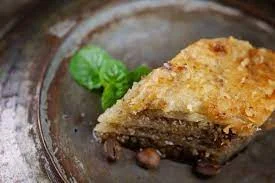
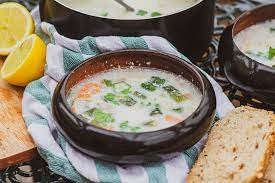
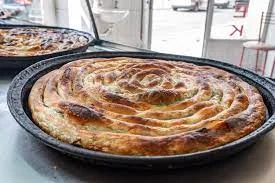
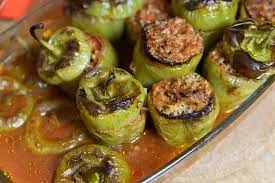
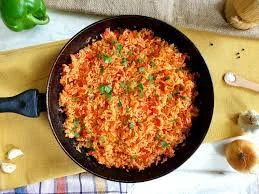
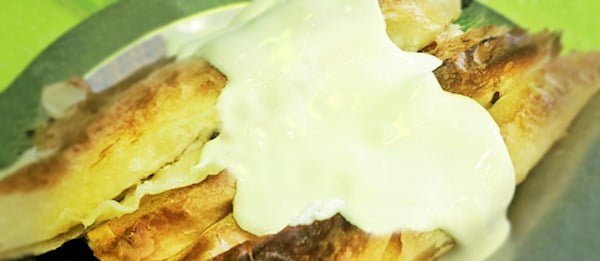
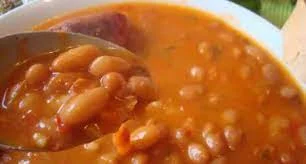

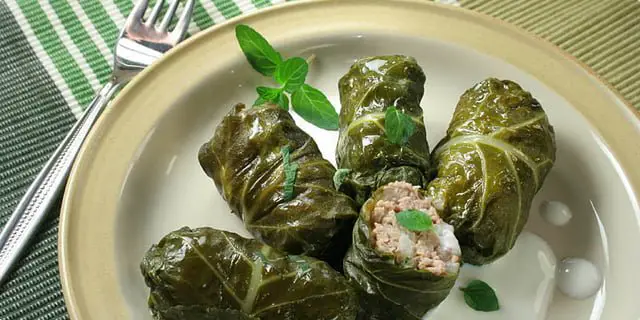
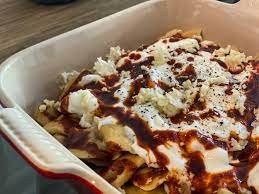
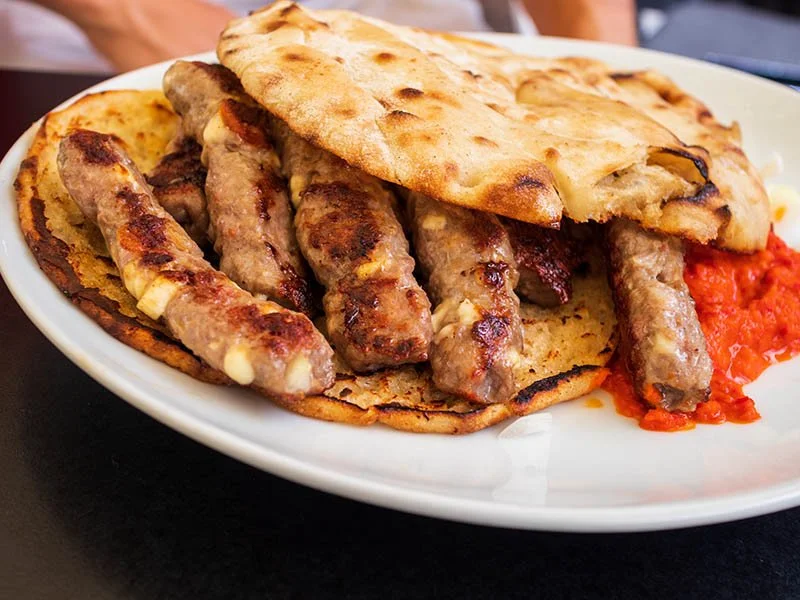
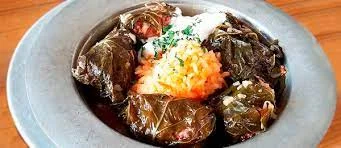
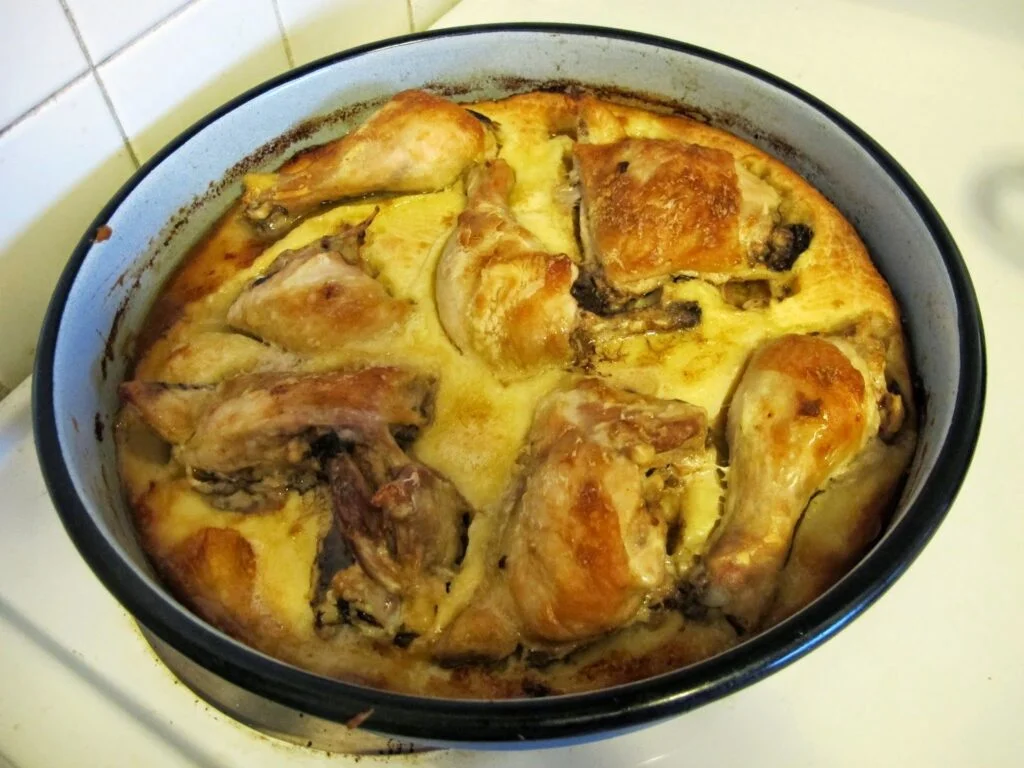
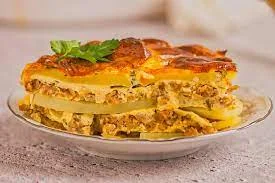
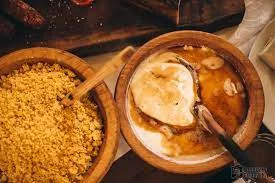
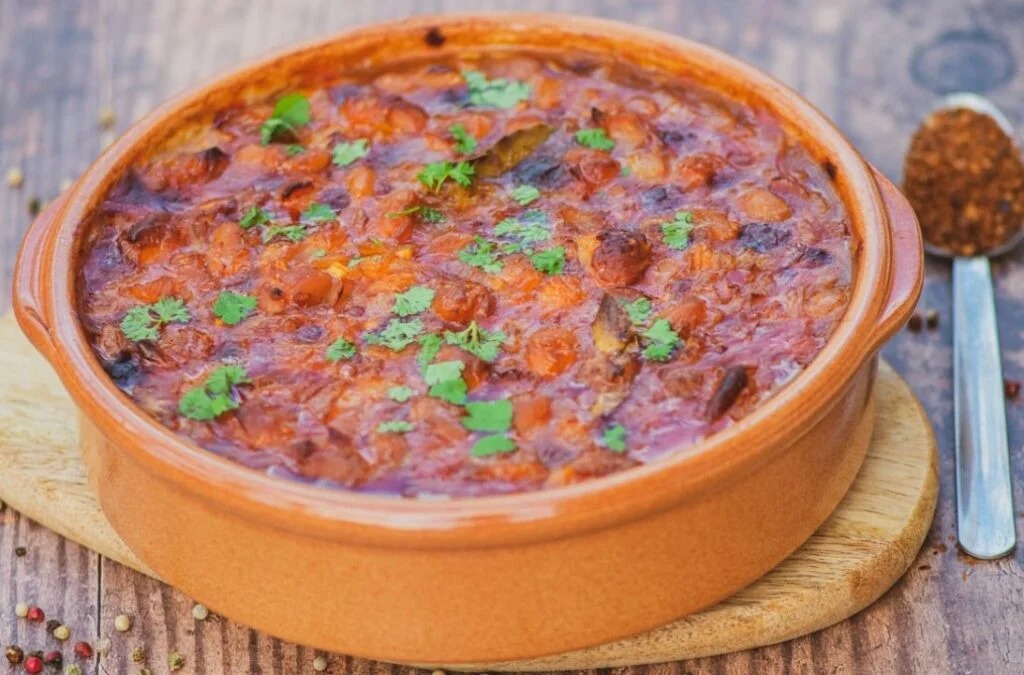
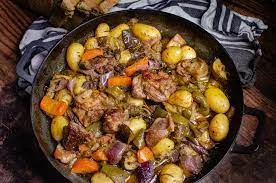
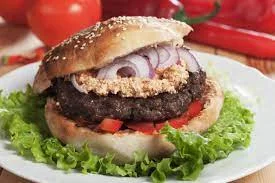
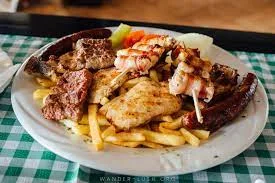
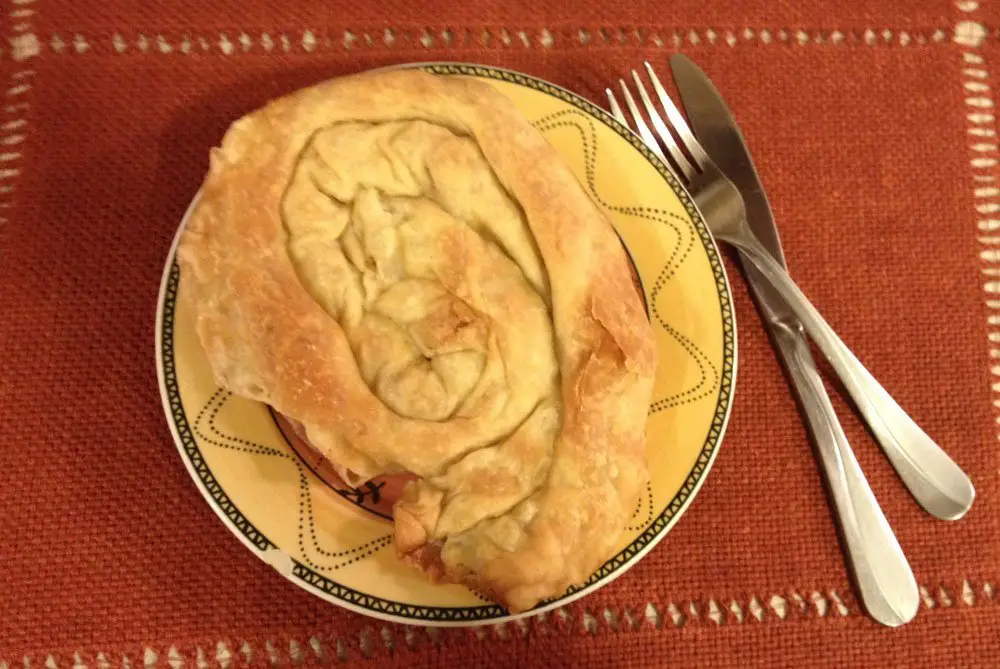
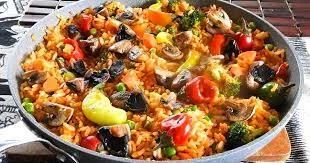
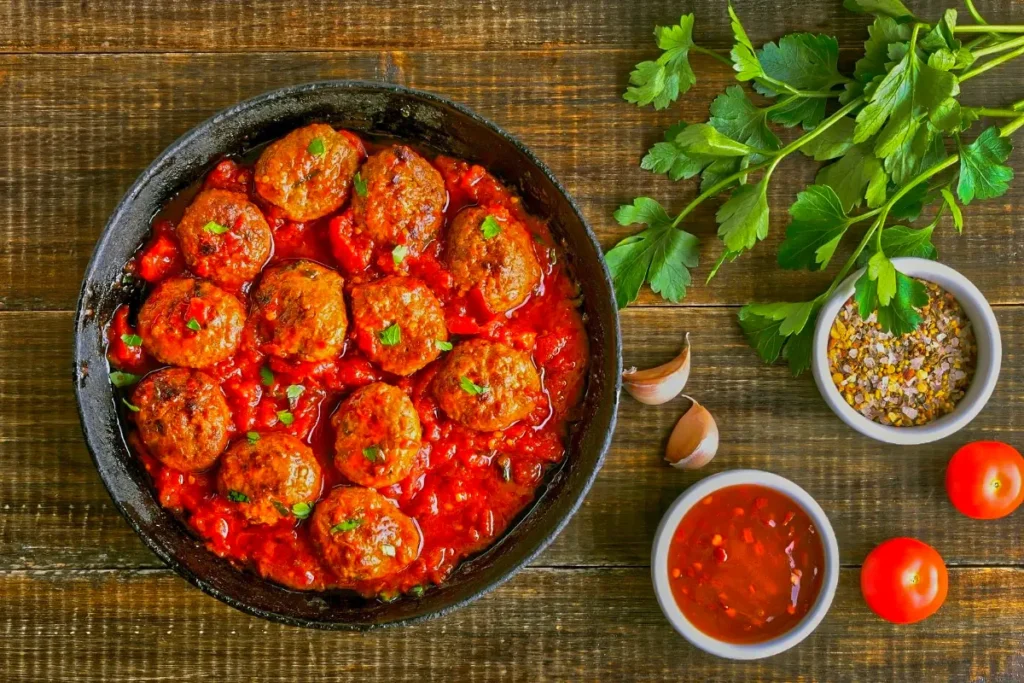
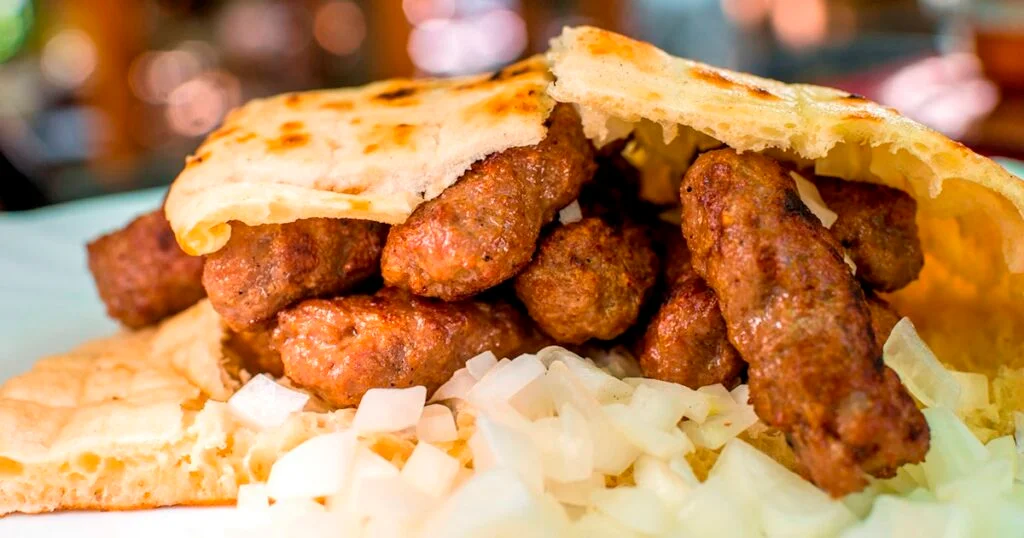
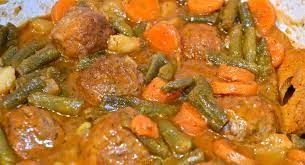
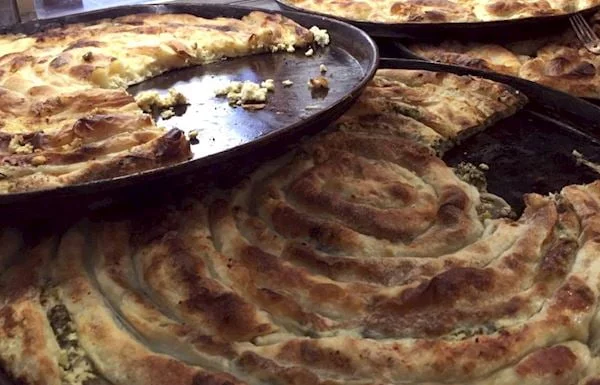
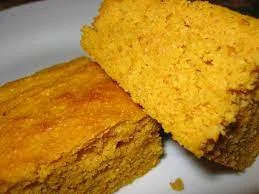
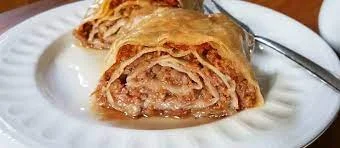

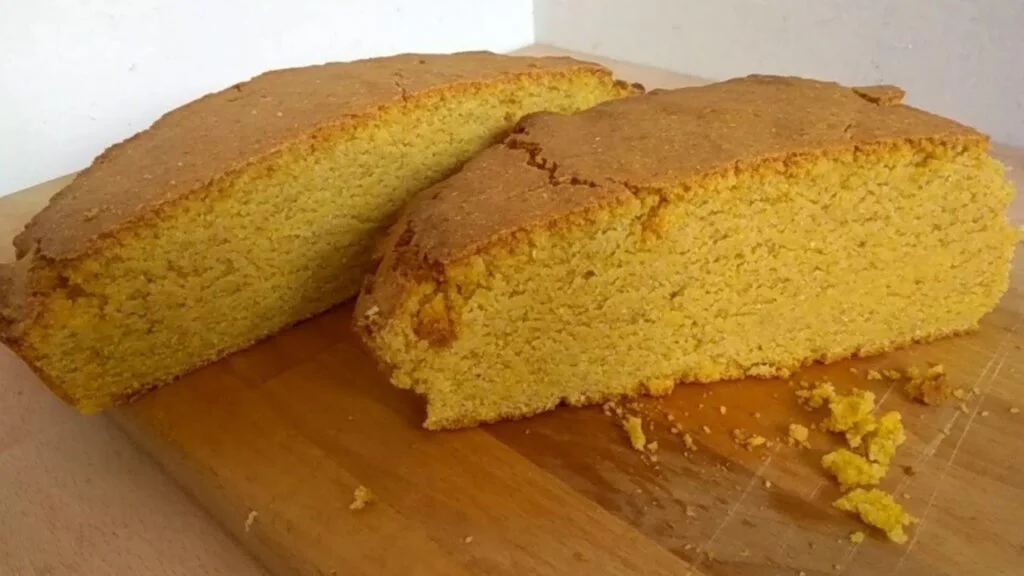
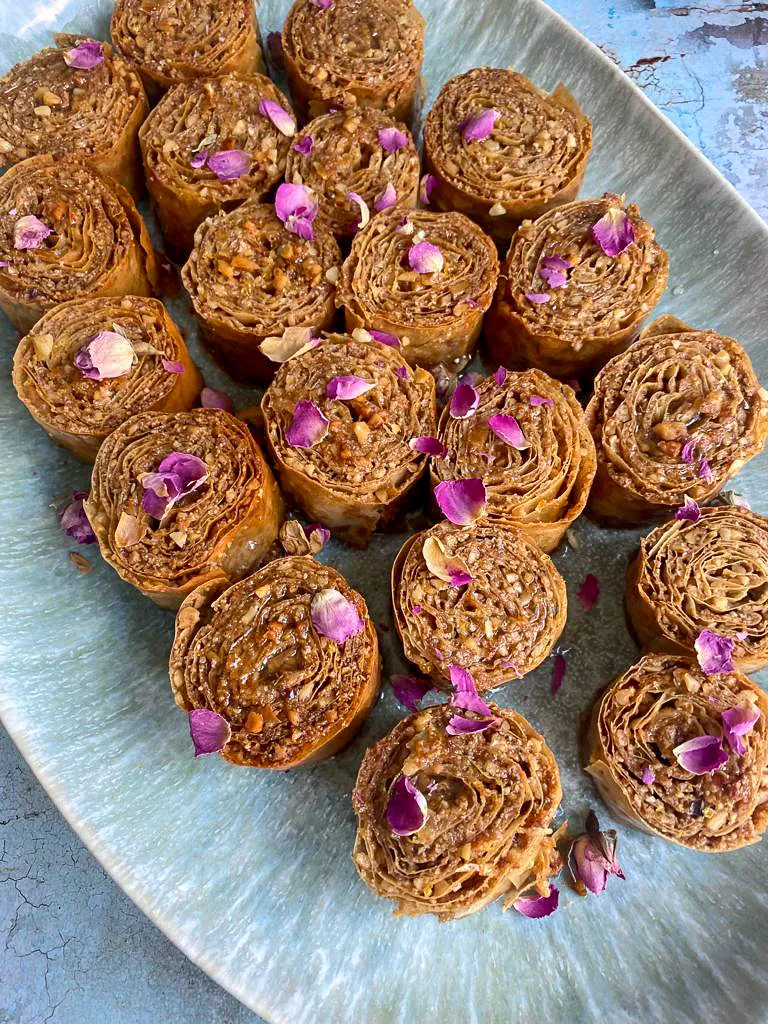

10 Fascinating Facts about Bosnia and Herzegovina

Bosnia and Herzegovina, a country nestled in the heart of the Balkans, boasts a rich tapestry of culture, history, and unique quirks. Let’s embark on a journey to uncover some of the most fascinating and peculiar laws and facts that make this nation truly stand out.
The Unique Land of Many Names
Bosnia and Herzegovina is one of the rare countries in the world to have three official languages: Bosnian, Croatian, and Serbian. This linguistic diversity reflects the intricate cultural tapestry woven throughout the region, making it a fascinating melting pot of identities.
Bridge Diving Tradition

Every summer, thrill-seekers and adrenaline junkies flock to Mostar, a city famous for its iconic Stari Most (Old Bridge), to partake in a centuries-old tradition—bridge diving.
Brave souls take a leap of faith from the bridge’s towering height into the Neretva River below, showcasing both courage and tradition in one breathtaking plunge.
Coffee Culture: A Way of Life
Bosnians take their coffee seriously, with a rich and deeply ingrained coffee culture that dates back centuries. Coffee isn’t merely a beverage; it’s a social ritual—a time for friends and family to gather, share stories, and savor the moment amidst the aromatic embrace of freshly brewed Bosnian coffee.
The Quirky License Plate Law

In Bosnia and Herzegovina, it’s not uncommon to spot cars with license plates featuring a seemingly random combination of letters and numbers.
However, there’s a method to this madness—each region in the country has its own distinct pattern, making it easy to identify where a vehicle is registered at a glance.
The Mysterious Pyramids of Visoko
Nestled amidst the hills of Visoko lies a controversial archaeological site that has sparked intrigue and debate—the Bosnian Pyramid Complex. Some claim these structures are ancient pyramids, rivaling those of Egypt, while others remain skeptical. Regardless of their origins, they continue to captivate the imagination of visitors from around the world.
The Phenomenon of Bosnian Rainbows

Bosnia and Herzegovina is renowned for its stunning natural beauty, including a curious meteorological phenomenon—Bosnian rainbows. These vibrant rainbows often appear in the skies above the country, casting a colorful spectacle that seems straight out of a fairy tale.
The Sarajevo Rose: Remnants of Conflict

Scattered throughout the streets of Sarajevo are haunting reminders of the country’s tumultuous past—the Sarajevo Roses.
These intricate patterns of mortar scars, filled with red resin, serve as poignant memorials to those who lost their lives during the siege of Sarajevo in the 1990s, transforming symbols of destruction into symbols of resilience and remembrance.
The Enigmatic Bosnian Pine
Hidden within the rugged landscapes of Bosnia and Herzegovina lies one of the oldest living organisms on Earth—the Bosnian Pine.
Some specimens of this resilient tree are estimated to be over 1,000 years old, bearing witness to centuries of history and standing as silent sentinels of the land.
The Breathtaking Beauty of Una National Park

Una National Park, located in the northwestern corner of Bosnia and Herzegovina, is a pristine wilderness teeming with natural wonders.
From cascading waterfalls to crystal-clear rivers, this protected area offers visitors a glimpse of untouched beauty and biodiversity.
The Melting Pot of Religious Diversity
Bosnia and Herzegovina is a testament to the harmonious coexistence of different faiths, with mosques, churches, and synagogues standing side by side in many cities. This religious diversity serves as a reminder of the country’s rich tapestry of cultural heritage and the spirit of tolerance that binds its people together.
Intrigued by the myriad wonders of Bosnia and Herzegovina? From ancient traditions to modern marvels, this captivating country never fails to surprise and delight those who venture to explore its depths.
Bosnia and Herzegovina History and the Effect on Cuisine
Bosnia and Herzegovina is a country in Southeast Europe that has a rich and diverse cuisine, influenced by its history and the cultures of various civilizations that have ruled or interacted with the region over the centuries. Some of the main historical factors that have affected the cuisine are:
Ottoman Era

The Ottoman Empire conquered Bosnia and Herzegovina in the 15th century and ruled it for more than 400 years. The Ottomans introduced many dishes and ingredients from their Turkish and Middle Eastern cuisine, such as stuffed vegetables, coffee, baklava, rice, dates, saffron, cardamom, turmeric, cinnamon, and cloves.
They also introduced the Islamic dietary laws, which prohibited pork and alcohol. The most famous dish from this era is ćevapi, or ćevapčići, which are small grilled minced meat links made of lamb and beef mix, served with onions, kajmak, ajvar, and Bosnian pita bread (somun).
Austro-Hungarian Era

In 1878, Bosnia and Herzegovina was occupied by the Austro-Hungarian Empire, which modernized and industrialized the region.
The Austro-Hungarians introduced many dishes and ingredients from their Central European cuisine, such as bread, butter, cheese, milk, cream, beer, and wine.
They also introduced the railway, the telegraph, and the education system, which facilitated the exchange of ideas and goods. Some of the dishes from this era are
- Gulaš (goulash), a meat and vegetable stew
- Burek (börek), a meat-filled flaky pastry;
- štrudla (strudel), a sweet pastry filled with fruit or cheese.
Yugoslavia Era

After World War I, Bosnia and Herzegovina became part of the Kingdom of Serbs, Croats, and Slovenes, which was later renamed Yugoslavia. Yugoslavia was under the leadership of Josip Broz Tito.
The region was influenced by the cuisines of other Yugoslav republics, such as Serbia, Croatia, Macedonia, and Montenegro.
Some of the dishes from this era are sarma, meat and rice rolled in pickled cabbage; pljeskavica, a patty dish; and grah/pasulj, a bean stew with meat. The region also developed its own variations of dishes from other regions, such as pilav (pilaf), a rice dish with meat and vegetables; and dolma, stuffed grape leaves or peppers.
War and Independence

In 1991, following the collapse of communism and the breakup of Yugoslavia, Bosnia and Herzegovina declared its independence, but faced a brutal and bloody war that lasted from 1992 to 1995. The war caused severe shortages of food and water and forced people to rely on humanitarian aid and survival skills.
The war also destroyed many cultural and historical monuments, such as the Old Bridge in Mostar, which was a symbol of the country’s diversity and tolerance. It also increased the ethnic and religious divisions among the people, which affected their food preferences and habits.
Contemporary Era
Since the end of the war, Bosnia and Herzegovina has faced many challenges and opportunities, such as the reconstruction and reconciliation, the integration into the European Union and NATO, the economic and social development, and the protection of human rights and democracy.
The country has also embraced its rich and diverse cuisine, which reflects its history and culture. The country has also been influenced by the cuisines of other countries, such as Italy, Greece, and China, as well as by the global trends of fast food, vegetarianism, and organic food.
References
How Bosnia and Herzegovina’s Climate and Geography Influences Food
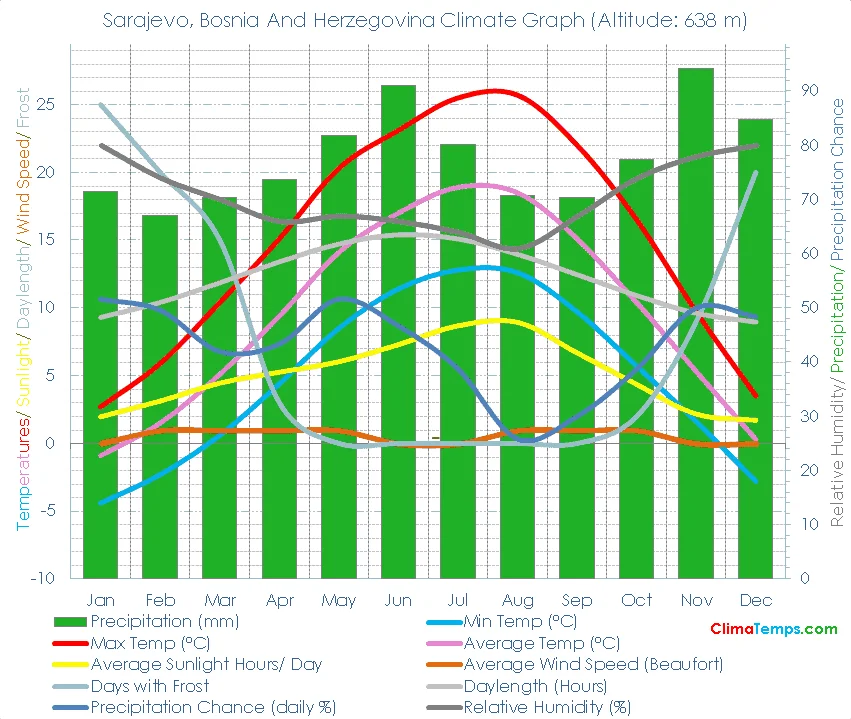
Bosnia and Herzegovina’s climate and geography have influenced its cuisine in several ways. Here are some of the main effects:
Seafood
The country has a short coastline on the Adriatic Sea, which provides a source of fish and shellfish, such as sardines, anchovies, mussels, and oysters. Seafood is often grilled, fried, or cooked in a stew with tomatoes, garlic, and herbs.
Some of the popular seafood dishes are riblja čorba (fish soup), brudet (fish stew), and Seafooduzara (shellfish in wine sauce).
Bosnia and Herzegovina Cuisine – Meat
The country has a mountainous and hilly terrain, which is suitable for raising livestock, such as sheep, goats, cattle, and pigs. Meat is a staple food in Bosnia and Herzegovina, especially lamb and beef, which are often roasted, grilled, or smoked.
Some of the popular meat dishes are ćevapi (grilled minced meat links), ražnjići (skewered meat), and begova čorba (lamb and vegetable soup). Pork is also consumed, but not by the Muslim population, who follow the Islamic dietary laws.
Bosnia and Herzegovina Cuisine – Dairy
The country has a temperate continental climate, with cold winters and warm summers. Dairy products, such as milk, cheese, butter, and cream, are widely used in the cuisine, as they are rich in calories and nutrients.
They are also used to make desserts, such as kajmak (clotted cream), sirnica (cheese pie), and tufahija (stuffed apples with cream). Some of the popular cheeses are travnički (sheep cheese), livanjski (hard cheese), and kajmak (soft cheese).
Bosnia and Herzegovina Cuisine – Bread
The country has fertile soil and suitable climate for growing cereals, such as wheat, barley, rye, and oats. Bread is a staple food in Bosnia and Herzegovina, and is eaten with almost every meal.
Bread is often baked in a wood-fired oven and comes in various shapes and sizes. Some of the popular types of bread are lepinja (flatbread), somun (pita bread), and pogača (round bread).
Bread is also used to make pastries, such as burek (meat-filled pastry), zeljanica (spinach-filled pastry), and baklava (nut-filled pastry)
References
- Climate in Bosnia and Herzegovina
- Bosnia and Herzegovina Cuisine
- jesseatsandtravels.com
- tuchmantravelguide.com
- britannica.com
- travelfoodatlas.com
Understanding the Essence of Bosnian Food Recipes
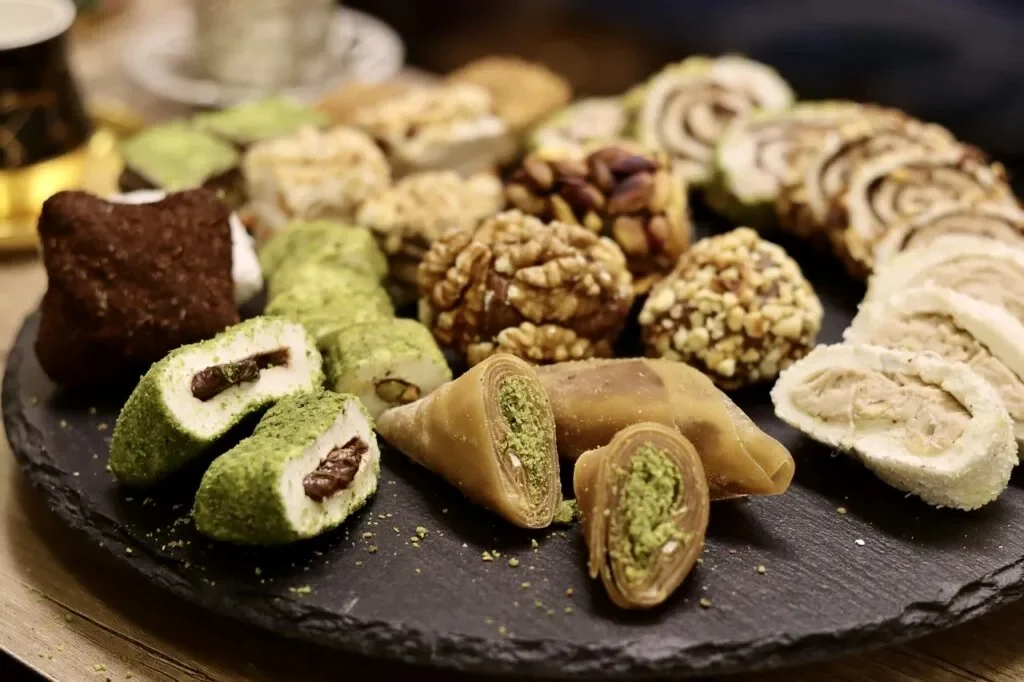
Forget the predictable – Bosnian cuisine is a vibrant tapestry woven from hearty stews, unexpected delights, and a unique blend of cultural influences. Here’s why Bosnian food should be your next culinary adventure:
A Symphony of Empires
Bosnia’s strategic location has made it a crossroads of empires for centuries, each leaving its mark on the national palate. Imagine a savory stew simmered for hours with fragrant spices like cumin and paprika, whispers of the Ottoman influence.
Next to it, you might find lighter dishes with a hint of European flair, featuring fresh vegetables and creamy sauces, a legacy of Austro-Hungarian rule. Bosnian cuisine is a beautiful harmony of East and West, offering a unique fusion of flavors in every bite.
Where Fresh Meets Comfort
Bosnia’s fertile valleys and rolling hills provide an abundance of ingredients that translate into delicious comfort food. Meat lovers will rejoice – lamb, beef, and chicken are the stars of stews, succulent grilled platters, and of course, the iconic ćevapi.
These small, savory sausages are a national treasure, traditionally nestled in warm pita bread with a symphony of chopped onions and kajmak (a thick cream) for a flavor explosion. Vegetarians needn’t fret – fresh vegetables like peppers, cabbage, and potatoes feature prominently in hearty stews and side dishes like “burek,” flaky pastries filled with savory delights like cheese, spinach, or potato.
This focus on fresh, seasonal produce ensures Bosnian cuisine is both soul-satisfying and incredibly delicious.
The Art of Slow Cooking
Bosnian cuisine elevates comfort food to an art form. Imagine “Bosanski lonac,” a national treasure – a hearty stew where tender meat, vegetables, and potatoes slow-cook in a clay pot, allowing the flavors to meld into a symphony of comfort.
“Sarma,” delicate grape leaves stuffed with rice and ground meat, offers a comforting familiarity and a delightful burst of flavor in every bite. These heartwarming dishes showcase Bosnia’s love for slow cooking, building layers of flavor that are perfect for a cozy night in.
Spice with Subtlety
Unlike some of its Balkan neighbors known for fiery chilis, Bosnian cuisine uses spices with a subtle touch. Paprika reigns supreme, adding a warm, smoky note to stews and grilled meats. Bay leaves and black pepper add depth without overpowering the natural flavors of the ingredients.
This nuanced approach allows the essence of fresh produce and meat to shine through, creating a symphony of delicate but satisfying flavors.
A Sweet Farewell
Bosnian cuisine doesn’t disappoint when it comes to sweet endings. “Baklava,” layers of flaky phyllo dough filled with chopped nuts and drenched in syrup, offers a decadent indulgence with a rich Ottoman heritage.
“Tufahija,” a fragrant dessert featuring stewed apples filled with walnuts and spices, is a delightful way to end a meal. Coffee, another legacy of Ottoman influence, is an integral part of Bosnian culture, enjoyed strong and thick, often accompanied by a piece of Turkish delight for the perfect sweet finale.
Traditional Bosnian Food

Some of the most popular and traditional dishes are:
- Ćevapi: Grilled minced meat links made of lamb and beef mix, served with onions, kajmak (clotted cream), ajvar (red pepper relish), and somun (pita bread).
- Burek: Flaky pastry filled with minced meat, cheese, spinach, or potatoes, usually eaten for breakfast or as a snack.
- Begova čorba Lamb and vegetable soup, thickened with okra and flour, and flavored with lemon and mint.
- Dolma: Stuffed grape leaves or peppers, filled with rice and meat, and cooked in a tomato sauce.
- Baklava: Sweet pastry made of layers of filo dough, filled with chopped nuts and honey, and cut into diamond shapes.
What Are the Health Implications of Bosnian Cuisine

According to the World Health Organization, the population of Bosnia and Herzegovina was 3,318,847 in 2020, with a life expectancy at birth of 76.5 years. The main causes of death in 2019 were ischemic heart disease, stroke, diabetes mellitus, prostate cancer, and breast cancer.
The prevalence of overweight and obesity among people aged 15 and older was 48% in 2016.
Like any cuisine, it has some health implications that depend on the quantity and quality of the food consumed. Here are some of the health implications of Bosnian cuisine:
Positive effects of Bosnian Cuisine
Bosnian cuisine can provide a balanced diet, as it contains carbohydrates, proteins, fats, vitamins, minerals, and fiber. Seafood is a good source of omega-3 fatty acids, which can lower the risk of cardiovascular diseases and improve brain function.
Spices can add flavor and aroma to the dishes, and also have anti-inflammatory, antioxidant, and antimicrobial properties.
Fruits and vegetables can provide vitamins, antioxidants, and phytochemicals, which can prevent chronic diseases, such as cancer, diabetes, and inflammation.
Negative effects of Bosnian Cuisine
Bosnian cuisine can also pose some health risks, such as high consumption of animal fats, salt, and sugar. Animal fats, such as lard, butter, and sour cream, are rich in saturated fats and cholesterol, which can increase the risk of cardiovascular diseases, such as high blood pressure, atherosclerosis, and heart attack.
Salt and sugar are used to preserve and flavor food, but excessive intake can cause problems such as high blood pressure, obesity, diabetes, tooth decay, and kidney damage.
Therefore, Bosnian cuisine can be enjoyed in moderation, but it is advisable to limit the intake of animal fats, salt, and sugar, and to increase the intake of fruits and vegetables.
Bosnia’s National Dish

At the heart of Bosnia’s culinary identity is ćevapi, or ćevapčići, its national dish, a symbol of unity and shared heritage.
These petite rolls of seasoned ground meat, usually a blend of beef and lamb, are grilled and commonly presented in a bread pocket. The plums indigenous to the region are frequently transformed into a dense jam or slivovitz, a well-liked brandy.
Exploring Bosnia Ingredients: The Flavors of Bosnia Cuisine
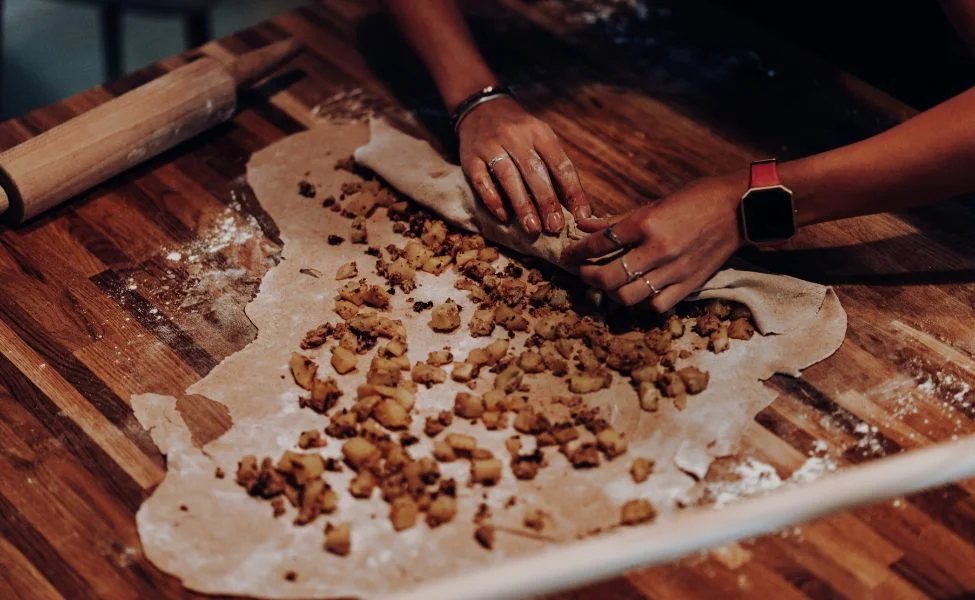
Delve into the diverse ingredients that define Bosnian cuisine. From succulent meats to flavorful spices, each component contributes to the harmonious symphony of tastes that grace Bosnian tables.
Embark on a journey through Bosnia and Herzegovina’s culinary wonders, where every dish narrates a story of resilience, cultural diversity, and a love for good food. Discover the essence of [Bosnia Food] and let your taste buds savor the rich tapestry of flavors woven by this enchanting Balkan nation.
Bosnian Recipes to Try at Home
Embarking on a culinary adventure through Bosnia and Herzegovina doesn’t necessarily require a passport – the heartwarming flavors of this Balkan nation can be savored right in your own kitchen.
Bosnian Food Dish – Baklava

History and Background of Bosnian Baklava
Baklava, a sweet and decadent pastry, holds a significant place in Bosnian culinary heritage. This dessert has a rich history, influenced by the Ottoman Empire’s presence in the region. The layers of phyllo dough, nuts, and honey syrup create a delightful combination that reflects the diverse cultural influences shaping Bosnian cuisine.
Baklava, with its flaky layers and sweet filling, has become a symbol of celebration and hospitality in Bosnia and Herzegovina.
Ingredients for Bosnian Food Baklava
- 1 pound phyllo dough
- 1 cup unsalted butter, melted.
- 2 cups mixed nuts (walnuts, pistachios, almonds), finely chopped
- 1 teaspoon ground cinnamon
- 1 cup granulated sugar.
- 1 cup water
- 1/2 cup honey
- 1 tablespoon lemon juice
- 1 teaspoon vanilla extract
Recipe for Bosnian Food Baklava
1. Prepare the Ingredients
- Preheat your oven to 350°F (175°C).
- Grease a baking dish with butter.
2. Layering the Phyllo Dough
- Place a sheet of phyllo dough in the baking dish.
- Brush melted butter over the phyllo sheet.
- Repeat the process with 7-8 layers of phyllo dough, brushing butter between each layer.
3. Add the Nut Mixture
- In a bowl, combine chopped nuts and ground cinnamon.
- Sprinkle a generous portion of the nut mixture over the layered phyllo dough.
4. Continue Layering
- Add 3-4 layers of phyllo dough, brushing with butter between each layer.
- Repeat the process of adding the nut mixture and layering until all ingredients are used.
5. Cut and Bake
- Using a sharp knife, cut the baklava into diamond or square shapes.
- Bake in the preheated oven for 45-50 minutes or until golden brown.
6. Prepare the Syrup
- In a saucepan, combine sugar, water, honey, lemon juice, and vanilla extract.
- Simmer over medium heat until the sugar dissolves, forming a syrup.
7. Pour the Syrup
- Once the baklava is out of the oven, immediately pour the hot syrup over it.
- Allow the baklava to absorb the syrup and cool for a few hours.
8. Serve
- Serve the Baklava at room temperature.
- Enjoy this delightful Bosnian treat with family and friends!
Serving Size, Cooking Time, and Nutritional Information
- Serving Size: 12-15 people
- Cooking Time: Approximately 1 hour
- Estimated Calories: 350 calories per serving (calories may vary based on specific ingredient brands and quantities used)
Bosnian Food Dish – Bajra
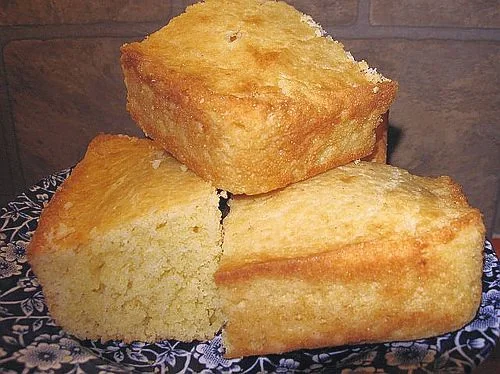
History and Background of Bosnian Bajra
Bajra, also known as Bosnian cornbread, is a traditional dish deeply rooted in Bosnia and Herzegovina’s culinary heritage. Originating from rural areas, where corn thrives, Bajra represents a staple food that sustained generations.
This simple yet hearty cornbread reflects the resilience and resourcefulness of Bosnian people. Often served alongside savory stews or grilled meats, Bajra embodies the essence of traditional Bosnian cuisine.
Ingredients for Bosnian Food Dish Bajra
- 2 cups cornmeal
- 1 cup all-purpose flour
- 1 teaspoon baking powder
- 1 teaspoon salt
- 2 cups buttermilk
- 2 eggs
- 1/4 cup vegetable oil
- 1 tablespoon sugar (optional)
Recipe for Bosnian Food Dish Bajra
1. Prepare the Ingredients
- Preheat your oven to 375°F (190°C).
- Grease a baking dish with oil or butter.
2. Mix Dry Ingredients
- In a large bowl, combine cornmeal, all-purpose flour, baking powder, and salt.
- If you prefer a sweeter cornbread, add sugar to the dry ingredients.
3. Add Wet Ingredients
- In a separate bowl, whisk together buttermilk, eggs, and vegetable oil.
- Pour the wet ingredients into the bowl with the dry ingredients.
4. Mix the Batter
- Stir the ingredients together until just combined, avoiding overmixing.
5. Bake the Bajra
- Pour the batter into the greased baking dish.
- Bake for 25-30 minutes or until a toothpick inserted into the center comes out clean.
6. Cool and Serve
- Allow the Bajra to cool for 10-15 minutes before slicing.
- Serve warm slices with butter or as an accompaniment to your favorite Bosnian dishes.
Serving Size, Cooking Time, and Nutritional Information
- Serving Size: 8-10 people
- Cooking Time: Approximately 30 minutes
- Estimated Calories: The calorie count for Bajra will vary based on specific brands and ingredient quantities. However, a typical serving may range from 150 to 200 calories per slice.
Bosnian Food Dish – Begova čorba
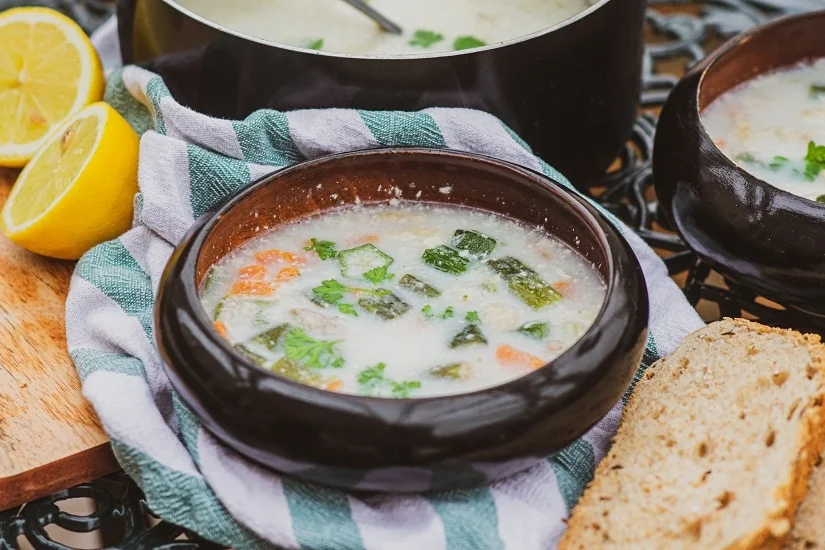
History and Background of Bosnian Begova Čorba
Begova Čorba, also known as Bey’s Soup, is a revered dish with origins tracing back to the Ottoman era in Bosnia and Herzegovina. This rich and velvety soup is believed to have been a favorite of the Ottoman rulers, reflecting the culinary sophistication of the time.
Named after the “bey,” or leader, this dish encapsulates the fusion of Ottoman and Bosnian influences, showcasing the historical ties that have shaped the region’s gastronomy.
Ingredients for Bosnian Food Dish Begova Čorba
- 1 cup chicken, cooked and shredded
- 1/2 cup butter
- 1/2 cup all-purpose flour
- 1 onion, finely chopped
- 2 carrots, diced
- 2 potatoes, diced
- 1/2 cup okra, sliced (optional)
- 6 cups chicken broth
- 1 cup heavy cream
- Salt and pepper to taste
- Ground nutmeg for garnish
Recipe for Bosnian Food Dish Begova Čorba
1. Prepare the Ingredients
- Cook and shred the chicken.
- Chop the onion, dice the carrots and potatoes, and slice the okra if using.
2. Make the Roux
- In a large pot, melt the butter over medium heat.
- Add the flour and stir continuously to create a roux, cooking until it turns golden brown.
3. Sauté Vegetables
- Add chopped onion to the roux and sauté until translucent.
- Add diced carrots, potatoes, and sliced okra. Sauté for an additional 5 minutes.
4. Add Chicken and Broth
- Incorporate the shredded chicken into the pot.
- Pour in the chicken broth, stirring to combine.
5. Simmer
- Allow the soup to simmer over medium-low heat until the vegetables are tender.
6. Finish the Soup
- Pour in the heavy cream, stirring gently.
- Season with salt and pepper to taste.
7. Serve
- Ladle the Begova Čorba into bowls.
- Garnish each serving with a sprinkle of ground nutmeg.
Serving Size, Cooking Time, and Nutritional Information
- Serving Size: 4-6 people
- Cooking Time: Approximately 45 minutes
- Estimated Calories: The calorie count for Begova Čorba will vary based on specific ingredient brands and quantities used. However, a typical serving may range from 300 to 400 calories per serving.
Bosnian Food Dish – buregdžinica

History and Background of Bosnian Buregdžinica
Buregdžinica is a quintessential Bosnian establishment, and its name is derived from “burek,” a popular Bosnian pastry. Burek holds a special place in Bosnian culinary culture, with its roots tracing back to the Ottoman Empire.
The dish reflects the historical connection between Bosnia and the Ottoman influence, showcasing layers of thin pastry filled with various ingredients like minced meat, cheese, or spinach. Buregdžinica, as a dedicated eatery, has become synonymous with warm hospitality and the cherished tradition of sharing delicious pastries.
Ingredients for Bosnian Food Dish – Burek
Dough:
- 1 pound phyllo dough
- 1 cup unsalted butter, melted
Filling:
- 1 pound ground beef or lamb
- 1 onion, finely chopped
- 1 cup feta cheese, crumbled
- 1 cup spinach, chopped (optional)
- Salt and pepper to taste
- 2 eggs (one for filling, one for brushing)
Recipe for Bosnian Food Dish – Burek
1. Prepare the Dough
- Preheat your oven to 375°F (190°C).
- Brush a baking dish with melted butter.
2. Make the Filling
- In a skillet, cook the ground meat over medium heat until browned.
- Add chopped onions and sauté until softened.
- If using spinach, add it to the skillet and cook until wilted.
- Remove from heat, stir in crumbled feta cheese, and season with salt and pepper.
3. Layer the Dough
- Lay one sheet of phyllo dough in the baking dish and brush with melted butter.
- Repeat the process, layering sheets and butter until you have about half of the phyllo dough.
4. Add the Filling
- Spread the meat and cheese mixture evenly over the layered phyllo dough.
5. Continue Layering
- Layer the remaining phyllo sheets, brushing each one with melted butter.
- Beat one egg and brush it over the top layer for a golden finish.
6. Bake
- Bake in the preheated oven for 30-35 minutes or until the burek is golden brown.
7. Serve
- Allow the burek to cool slightly before slicing.
- Serve warm as a delightful snack or meal.
Serving Size, Cooking Time, and Nutritional Information
- Serving Size: 8-10 people
- Cooking Time: Approximately 45 minutes
- Estimated Calories: The calorie count for burek will vary based on specific ingredient brands and quantities used. However, a typical serving may range from 300 to 400 calories per serving.
Bosnian Food – Dolma

Dolma: A Storied Delight from Bosnia and Herzegovina
History and Background: Dolma, a culinary masterpiece from Bosnia and Herzegovina, reflects the rich history and cultural diversity of the region. This dish, whose name means “stuffed” in Turkish, found its way into Bosnian kitchens through centuries of Ottoman influence.
Originally, Dolma referred to grape leaves stuffed with a flavorful mixture, and today, it stands as a symbol of the fusion of Ottoman and Balkan culinary traditions.
Bosnian Food – Dolma Ingredients
Grape Leaves:
- 1 jar of grape leaves in brine (about 60 leaves)
- 1 cup rice, washed and drained
- 500g ground beef or lamb
- 1 large onion, finely chopped
- 1/2 cup pine nuts
- 1/2 cup currants
- 1/4 cup chopped fresh mint
- 1/4 cup chopped fresh parsley
- 2 tablespoons tomato paste
- 1 teaspoon ground allspice
- Salt and pepper to taste
Cooking:
- 2 lemons, sliced
- Olive oil
- Water
Bosnian Food – Dolma Ingredients Recipe
Preparing the Grape Leaves
- Rinse and Soak:
- Rinse the grape leaves under cold water and soak them in warm water for about 30 minutes to reduce saltiness.
- Filling Mixture:
- In a bowl, combine rice, ground meat, chopped onion, pine nuts, currants, mint, parsley, tomato paste, allspice, salt, and pepper.
Assembling Dolma
- Stuffing Grape Leaves:
- Lay a grape leaf flat, place a spoonful of the filling in the center.
- Fold the sides of the leaf inward and roll it tightly.
- Layering in the Pot:
- Place lemon slices at the bottom of a large pot.
- Arrange the rolled grape leaves on top of the lemons.
- Cooking Dolma:
- Drizzle olive oil over the Dolma.
- Add water until the Dolma is just covered.
- Place a plate on top to prevent Dolma from unraveling during cooking.
- Simmer over low heat for 45-60 minutes until the rice is cooked.
Serving Dolma
- Cool and Serve:
- Allow Dolma to cool before serving.
- Serve with a dollop of yogurt if desired.
Serving Size: 4-6 people
Estimated Cooking Time: 1.5 hours
Calories (per serving): Approximately 300 calories
Bosnian Food – Burek

Burek: A Culinary Gem from Bosnia and Herzegovina
History and Background: Burek, a beloved pastry in Bosnia and Herzegovina, traces its origins to the Ottoman era, showcasing the cultural amalgamation that defines the region. This savory pie, with its flaky layers and various fillings, has become an integral part of Bosnian cuisine.
Whether enjoyed as a snack, breakfast, or celebratory dish, Burek carries the essence of centuries-old culinary traditions.
Bosnian Food – Burek Ingredients:
Dough:
- 500g phyllo dough (store-bought or homemade)
- 1 cup water
- 1 cup yogurt
- 1/2 cup vegetable oil
- 1 teaspoon salt
Filling:
- 500g ground beef or a mixture of beef and lamb
- 1 large onion, finely chopped
- 2 tablespoons vegetable oil
- Salt and pepper to taste
Assembly:
- 1 cup sparkling water
- 1/2 cup vegetable oil
Bosnian Food – Burek Recipe
Making the Dough
- Prepare the Liquid Mixture:
- In a bowl, mix water, yogurt, vegetable oil, and salt.
- Combine with Phyllo Dough:
- Gradually add the liquid mixture to the phyllo dough, mixing until a soft and pliable dough forms.
Preparing the Filling
- Saute Onions:
- In a pan, sauté finely chopped onions in vegetable oil until golden.
- Cook Ground Meat:
- Add ground meat to the pan and cook until browned.
- Season with salt and pepper to taste.
Assembling Burek
- Roll Out the Dough:
- Divide the dough into equal-sized balls and roll each ball into a thin sheet.
- Layering and Folding:
- Brush each layer with a mixture of sparkling water and vegetable oil.
- Place a portion of the filling along one edge and roll the dough into a spiral.
- Baking:
- Preheat the oven to 180°C (350°F).
- Place the rolled Burek on a baking sheet and bake for 30-40 minutes or until golden brown.
Serving Burek
- Slice and Enjoy:
- Allow Burek to cool slightly before slicing into portions.
- Serve warm and enjoy the flaky layers and savory filling.
Serving Size: 6-8 people
Estimated Cooking Time: 1 hour
Calories (per serving): Approximately 400 calories
Bosnian Food Dish – Buranija

History and Background of Bosnian Buranija
Buranija, a traditional Bosnian dish, showcases the region’s reliance on fresh, locally sourced ingredients. The name “buranija” is often associated with green beans, the main component of the dish.
This hearty and flavorful recipe reflects Bosnia and Herzegovina’s agricultural heritage, where vegetables like green beans are cultivated in abundance. Buranija is a celebration of simplicity, highlighting the natural flavors of seasonal produce and the importance of home-cooked meals in Bosnian culture.
Ingredients for Bosnian Food Dish – Buranija
- 1 pound fresh green beans, ends trimmed and halved
- 1 onion, finely chopped
- 2 cloves garlic, minced
- 2 medium-sized potatoes, peeled and diced
- 2 medium-sized carrots, peeled and sliced
- 1 red bell pepper, diced
- 2 tomatoes, diced
- 2 tablespoons vegetable oil
- 1 teaspoon paprika
- Salt and pepper to taste
- Fresh parsley for garnish
Recipe for Bosnian Food Dish – Buranija
1. Prepare the Ingredients
- Trim and halve the green beans.
- Chop the onion, mince the garlic, peel and dice the potatoes, slice the carrots, and dice the red bell pepper and tomatoes.
2. Sauté Vegetables
- In a large pot, heat vegetable oil over medium heat.
- Add chopped onions and minced garlic, sautéing until softened.
3. Add Potatoes and Carrots
- Incorporate diced potatoes and sliced carrots into the pot, stirring for a few minutes.
4. Introduce Green Beans
- Add the trimmed and halved green beans to the pot, continuing to sauté the vegetables.
5. Season the Mixture
- Sprinkle paprika over the vegetables and season with salt and pepper to taste.
- Stir to evenly coat the vegetables with the seasonings.
6. Simmer
- Pour enough water into the pot to cover the vegetables.
- Bring the mixture to a boil, then reduce the heat to simmer until all vegetables are tender.
7. Add Bell Pepper and Tomatoes
- Stir in diced red bell pepper and tomatoes, allowing them to cook for an additional 10-15 minutes.
8. Garnish and Serve
- Garnish the buranija with fresh parsley before serving.
- Serve the dish warm as a side or a standalone meal.
Serving Size, Cooking Time, and Nutritional Information
- Serving Size: 4-6 people
- Cooking Time: Approximately 45 minutes
- Estimated Calories: The calorie count for buranija will vary based on specific ingredient brands and quantities used. However, a typical serving may range from 150 to 200 calories per serving.
Bosnian Food Dish – ćevapi

History and Background of Bosnian Ćevapi
Ćevapi, a beloved Bosnian dish, has its roots deeply embedded in the culinary history of the Balkans. These small, grilled minced meat sausages are a testament to the region’s Ottoman influence. Originating during the Ottoman era, Ćevapi quickly became a staple in Bosnian cuisine.
These flavorful, hand-shaped sausages are traditionally made with a blend of ground meats and are often served with somun (flatbread), diced onions, and a side of kajmak (a creamy dairy product). Ćevapi are not just a meal; they represent a cultural connection to Bosnia’s past and a celebration of the art of grilling.
Ingredients for Bosnian Food Dish – Ćevapi
- 1 pound ground beef
- 1/2 pound ground lamb
- 1/2 pound ground veal
- 1 small onion, finely grated
- 2 cloves garlic, minced
- 1 teaspoon baking soda
- 1 teaspoon paprika
- Salt and pepper to taste
- Flatbread (somun) for serving
- Diced onions for garnish
- Kajmak or sour cream for serving
Recipe for Bosnian Food Dish – Ćevapi
1. Prepare the Meat Mixture
- In a large mixing bowl, combine ground beef, ground lamb, and ground veal.
- Add finely grated onion, minced garlic, baking soda, paprika, salt, and pepper to the meat mixture.
2. Mix Thoroughly
- Use your hands to thoroughly mix the ingredients until well combined.
- Cover the bowl and let the mixture rest in the refrigerator for at least 1 hour to allow the flavors to meld.
3. Shape the Ćevapi
- Take small portions of the meat mixture and shape them into finger-sized sausages.
4. Grill the Ćevapi
- Preheat a grill or grill pan over medium-high heat.
- Grill the Ćevapi for approximately 10-12 minutes, turning occasionally, until they are fully cooked and have a golden-brown exterior.
5. Serve
- Warm the flatbread (somun) on the grill.
- Serve the Ćevapi hot on the flatbread, garnished with diced onions.
- Accompany with kajmak or sour cream on the side.
Serving Size, Cooking Time, and Nutritional Information
- Serving Size: 4-6 people
- Cooking Time: Approximately 15-20 minutes
- Estimated Calories: The calorie count for Ćevapi will vary based on specific ingredient brands and quantities used. However, a typical serving may range from 300 to 400 calories per serving.
Bosnian Food Dish – Cutfe

History and Background of Bosnian Cutfe (Meatballs in Tomato Gravy)
Cutfe, also known as meatballs in tomato gravy, is a comforting Bosnian dish deeply rooted in the culinary traditions of Bosnia and Herzegovina. This hearty and flavorful dish showcases the influence of Ottoman and Middle Eastern cuisines in the region. The dish’s name, “cutfe,” signifies the cultural connection between the diverse culinary histories that have shaped Bosnia. Often served with rice or pasta, Cutfe has become a staple in Bosnian households, representing the warmth and hospitality of the country’s food culture.
Ingredients for Bosnian Food Dish – Cutfe (Meatballs in Tomato Gravy)
Meatballs:
- 1 pound ground beef
- 1/2 cup breadcrumbs
- 1 onion, finely chopped
- 2 cloves garlic, minced
- 1 egg
- 1 teaspoon paprika
- Salt and pepper to taste
Tomato Gravy:
- 2 tablespoons vegetable oil
- 1 onion, finely chopped
- 2 cloves garlic, minced
- 1 can (14 oz) crushed tomatoes
- 1 tablespoon tomato paste
- 1 teaspoon paprika
- 1 teaspoon dried oregano
- Salt and pepper to taste
- 2 cups beef or vegetable broth
Serving:
- Cooked rice or pasta
- Chopped fresh parsley for garnish
Recipe for Bosnian Food Dish – Cutfe (Meatballs in Tomato Gravy)
1. Prepare the Meatballs
- In a bowl, combine ground beef, breadcrumbs, chopped onion, minced garlic, egg, paprika, salt, and pepper.
- Mix the ingredients thoroughly and shape the mixture into small meatballs.
2. Brown the Meatballs
- In a skillet, heat vegetable oil over medium-high heat.
- Brown the meatballs on all sides, then remove them from the skillet and set aside.
3. Make the Tomato Gravy
- In the same skillet, sauté chopped onion and minced garlic until softened.
- Add crushed tomatoes, tomato paste, paprika, dried oregano, salt, and pepper.
- Pour in beef or vegetable broth, stirring to combine.
4. Simmer
- Allow the tomato gravy to simmer for 10-15 minutes to develop flavors.
5. Add Meatballs
- Gently place the browned meatballs into the tomato gravy.
- Simmer for an additional 15-20 minutes until the meatballs are cooked through.
6. Serve
- Serve the cutfe over cooked rice or pasta.
- Garnish with chopped fresh parsley.
Serving Size, Cooking Time, and Nutritional Information
- Serving Size: 4-6 people
- Cooking Time: Approximately 45 minutes
- Estimated Calories: The calorie count for Cutfe will vary based on specific ingredient brands and quantities used. However, a typical serving may range from 400 to 500 calories per serving.
Bosnian Food Dish – Djuvec (vegetarian rice)
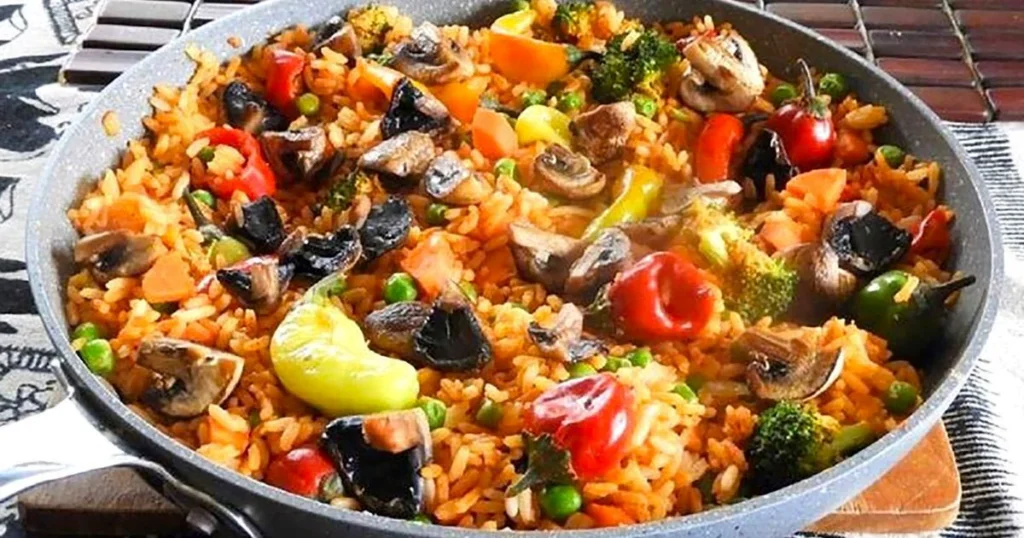
History and Background of Bosnian Djuvec (Vegetarian Rice)
Djuvec, a flavorsome vegetarian rice dish, has deep roots in Bosnian cuisine, showcasing the influence of Ottoman and Mediterranean culinary traditions. Originating from the rich agricultural practices in Bosnia and Herzegovina, Djuvec highlights the abundance of fresh, seasonal vegetables in the region.
The dish’s name is derived from the Turkish word “türlüce,” emphasizing the diverse mix of vegetables that characterize this hearty and nutritious meal. Djuvec has become a staple on Bosnian tables, symbolizing the country’s commitment to simple, yet satisfying, vegetarian fare.
Ingredients for Bosnian Food Dish – Djuvec (vegetarian rice)
- 1 cup long-grain rice
- 2 tablespoons vegetable oil
- 1 onion, finely chopped
- 2 cloves garlic, minced
- 1 red bell pepper, diced
- 1 yellow bell pepper, diced
- 1 zucchini, diced
- 1 eggplant, diced
- 2 tomatoes, diced
- 1 cup green beans, chopped
- 1 teaspoon paprika
- Salt and pepper to taste
- 2 cups vegetable broth
- Chopped fresh parsley for garnish
Recipe for Bosnian Food Dish – Djuvec (vegetarian rice)
1. Prepare the Ingredients
- Rinse the rice under cold water until the water runs clear.
- In a large skillet, heat vegetable oil over medium heat.
2. Sauté Onion and Garlic
- Sauté finely chopped onion and minced garlic in the skillet until softened.
3. Add Vegetables
- Incorporate diced red and yellow bell peppers, zucchini, eggplant, tomatoes, and green beans into the skillet.
4. Season the Vegetables
- Sprinkle paprika, salt, and pepper over the vegetables, stirring to coat evenly.
5. Add Rice
- Add the rinsed rice to the skillet, stirring to combine with the vegetables.
6. Pour Vegetable Broth
- Pour vegetable broth over the rice and vegetables, ensuring everything is submerged in liquid.
7. Simmer
- Cover the skillet and simmer over low heat for 20-25 minutes or until the rice is cooked and the vegetables are tender.
8. Garnish and Serve
- Garnish the Djuvec with chopped fresh parsley.
- Serve warm as a standalone dish or as a flavorful side.
Serving Size, Cooking Time, and Nutritional Information
- Serving Size: 4-6 people
- Cooking Time: Approximately 30 minutes
- Estimated Calories: The calorie count for Djuvec will vary based on specific ingredient brands and quantities used. However, a typical serving may range from 250 to 300 calories per serving.
Bosnian Food Dish – đuveč
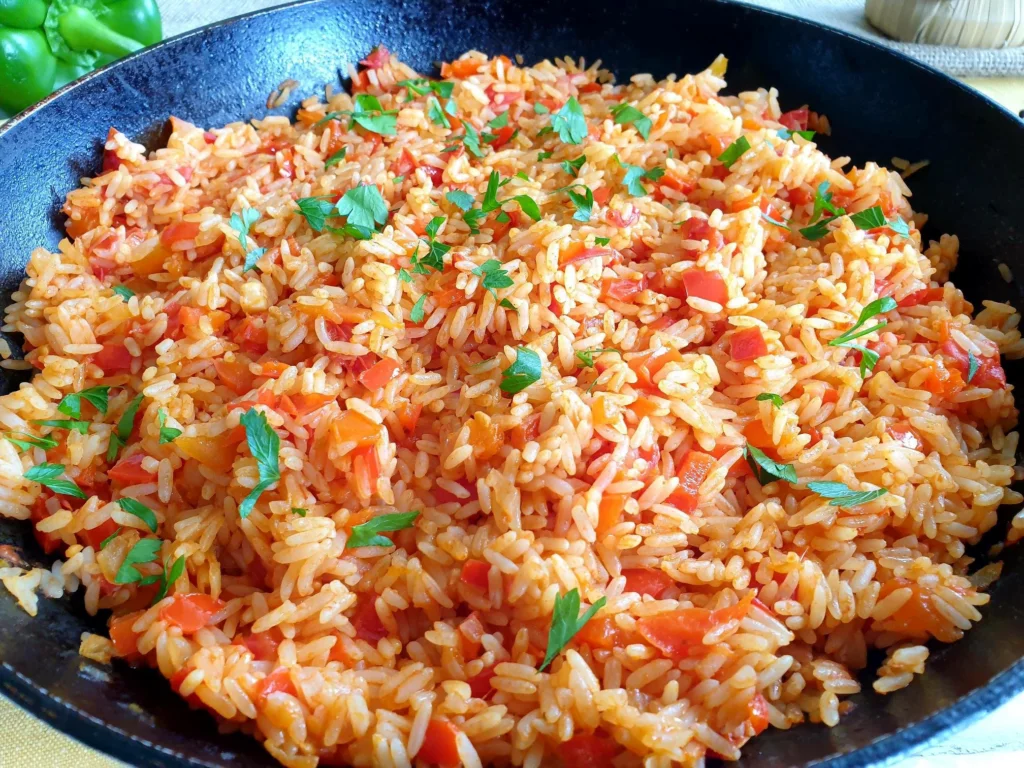
History and Background of Bosnian Đuveč
Đuveč, a quintessential Bosnian dish, reflects the culinary diversity and cultural influences of Bosnia and Herzegovina. Originating from the Ottoman era, this one-pot wonder showcases the region’s agricultural bounty and the blending of flavors from different civilizations.
The name “đuveč” is derived from the Turkish word “duvec,” emphasizing the dish’s Ottoman roots. Typically prepared with a mix of vegetables and meat, đuveč represents the heartiness and simplicity of Bosnian home cooking, making it a beloved comfort food for generations.
Ingredients for Bosnian Food Dish – Đuveč
Base:
- 1 cup rice
- 2 tablespoons vegetable oil
- 1 onion, finely chopped
- 2 cloves garlic, minced
- 1 red bell pepper, diced
- 1 yellow bell pepper, diced
- 2 carrots, sliced.
- 1 zucchini, diced
- 1 cup green beans, chopped
- 1 cup peas (fresh or frozen)
- 2 tomatoes, diced
- 1 teaspoon paprika
- Salt and pepper to taste
Meat (Optional):
- 1 pound beef or chicken, diced
Broth:
- 4 cups vegetable or meat broth
Garnish:
- Chopped fresh parsley
Recipe for Bosnian Food Dish – Đuveč
1. Prepare the Base
- Rinse the rice under cold water until the water runs clear.
- In a large pot, heat vegetable oil over medium heat.
- Sauté chopped onion and minced garlic until softened.
2. Add Vegetables
- Incorporate diced red and yellow bell peppers, sliced carrots, diced zucchini, chopped green beans, peas, and diced tomatoes into the pot.
3. Season
- Sprinkle paprika, salt, and pepper over the vegetables, stirring to coat evenly.
4. Add Rice and Meat
- Add rinsed rice to the pot, stirring to combine.
- If using meat, add diced beef or chicken to the mixture.
5. Pour Broth
- Pour vegetable or meat broth into the pot, ensuring all ingredients are submerged in liquid.
6. Cook
- Bring the mixture to a boil, then reduce the heat to simmer.
- Cover the pot and cook for 20-25 minutes or until the rice is tender and the liquid is absorbed.
7. Garnish and Serve
- Garnish the đuveč with chopped fresh parsley.
- Serve warm as a hearty main dish.
Serving Size, Cooking Time, and Nutritional Information
- Serving Size: 4-6 people
- Cooking Time: Approximately 30 minutes
- Estimated Calories: The calorie count for đuveč will vary based on specific ingredient brands and quantities used. However, a typical serving may range from 300 to 400 calories per serving.
Bosnian Food Dish – Forino

History and Background of Bosnian Forino
Forino, a delightful Bosnian dish, holds a special place in the country’s culinary landscape. This comforting dish, featuring a combination of eggs, yogurt, and other simple ingredients, reflects the resourcefulness of Bosnian cuisine. Originating from the rural areas of Bosnia and Herzegovina, forino is a dish that resonates with the agricultural traditions of the region.
The name “forino” is likely derived from the Italian word “frittata,” underscoring the cross-cultural influences that have shaped Bosnian gastronomy over the centuries.
Ingredients for Bosnian Food Dish – Forino
- 6 eggs
- 1 cup plain yogurt
- 1/2 cup flour
- 1/2 teaspoon baking powder
- Salt and pepper to taste
- 1 cup feta cheese, crumbled
- 1/2 cup cooked spinach, chopped
- 1/4 cup chopped fresh parsley
- 2 tablespoons vegetable oil
Recipe for Bosnian Food Dish – Forino
1. Prepare the Ingredients
- Preheat your oven to 375°F (190°C).
- In a bowl, whisk together eggs, yogurt, flour, baking powder, salt, and pepper until well combined.
2. Add Filling Ingredients
- Gently fold in crumbled feta cheese, cooked spinach, and chopped fresh parsley into the egg mixture.
3. Grease the Baking Dish
- Grease a baking dish with vegetable oil.
4. Pour the Mixture
- Pour the egg and filling mixture into the prepared baking dish.
5. Bake
- Bake in the preheated oven for 25-30 minutes or until the forino is set and golden brown on top.
6. Serve
- Allow the forino to cool for a few minutes before slicing.
- Serve warm as a savory and satisfying dish.
Serving Size, Cooking Time, and Nutritional Information
- Serving Size: 4-6 people
- Cooking Time: Approximately 30 minutes
- Estimated Calories: The calorie count for forino will vary based on specific ingredient brands and quantities used. However, a typical serving may range from 200 to 300 calories per serving.
Bosnian Food Dish – Grah
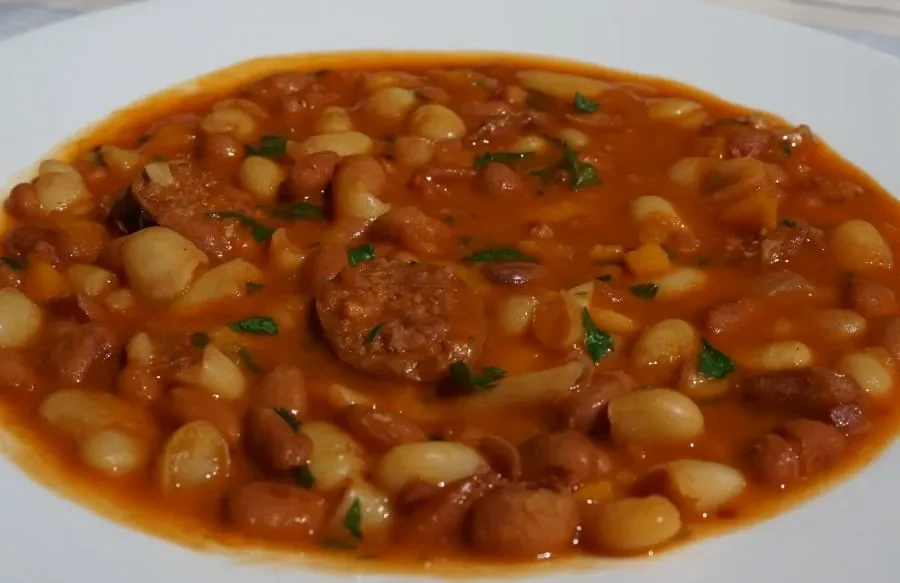
History and Background of Bosnian Grah
Grah, a beloved Bosnian dish, traces its origins back to the hearty and nourishing meals of the Balkan region. Rooted in the Ottoman influence on Bosnian cuisine, grah signifies the fusion of diverse flavors and culinary traditions.
The name “grah” itself translates to “beans” in Bosnian, highlighting the staple ingredient of this dish. Beyond its humble roots, grah has become a symbol of comfort and sustenance, embodying the spirit of Bosnian home cooking and hospitality.
Ingredients for Bosnian Food Dish – Grah
Beans:
- 2 cups dried kidney beans
- Water for soaking and boiling
- 1 onion, chopped
- 2 cloves garlic, minced
- 2 bay leaves
- Salt to taste
Base:
- 2 tablespoons vegetable oil
- 1 onion, finely chopped
- 2 carrots, diced
- 2 celery stalks, diced
- 1 red bell pepper, diced
- 1 tablespoon tomato paste
- 2 tomatoes, diced
- 1 teaspoon paprika
- Salt and pepper to taste
Serving:
- Cooked rice
- Chopped fresh parsley
Recipe for Bosnian Food Dish – Grah
1. Prepare the Beans
- Soak dried kidney beans in water overnight.
- Rinse the beans and cook in a large pot with fresh water, chopped onion, minced garlic, bay leaves, and salt until tender.
2. Sauté the Base
- In a separate pot, heat vegetable oil over medium heat.
- Sauté finely chopped onion, diced carrots, diced celery, and diced red bell pepper until softened.
3. Add Tomato Paste and Tomatoes
- Stir in tomato paste and diced tomatoes, cooking until the mixture becomes saucy.
4. Season
- Add paprika, salt, and pepper to the base, adjusting to taste.
5. Combine with Beans
- Incorporate the cooked kidney beans along with some of their cooking liquid into the vegetable base.
6. Simmer
- Allow the grah to simmer over low heat for at least 30 minutes to allow flavors to meld.
7. Serve
- Serve the grah over cooked rice.
- Garnish with chopped fresh parsley.
Serving Size, Cooking Time, and Nutritional Information
- Serving Size: 6-8 people
- Cooking Time: Approximately 2 hours (including bean soaking and cooking)
- Estimated Calories: The calorie count for grah will vary based on specific ingredient brands and quantities used. However, a typical serving may range from 300 to 400 calories per serving.
Bosnian Food Dish – Hurmasice

History and Background of Bosnian Hurmašice
Hurmašice, a delightful Bosnian dessert, has its roots deeply embedded in the culinary history of Bosnia and Herzegovina. Originating from the Ottoman era, hurmašice represents a fusion of cultural influences that have shaped Bosnian sweets.
The name “hurmašice” is derived from the Turkish word “hurma,” meaning date, showcasing the traditional use of dates in the recipe. These small, syrup-soaked cookies are a staple during festive occasions, symbolizing the sweetness of Bosnian hospitality and celebrations.
Ingredients for Bosnian Food Dish – Hurmašice
Dough:
- 1 cup unsalted butter, softened
- 1 cup sugar
- 2 eggs
- 1 cup plain yogurt
- 1 teaspoon baking soda
- 4 cups all-purpose flour
Filling:
- 1 cup ground walnuts
- 1/2 cup sugar
- 1 teaspoon ground cinnamon
Syrup:
- 2 cups sugar
- 1 cup water
- 1 lemon, sliced
- 1 tablespoon honey
Recipe for Bosnian Food Dish – Hurmašice
1. Prepare the Dough
- In a large bowl, cream together softened butter and sugar until light and fluffy.
- Add eggs one at a time, beating well after each addition.
- Dissolve baking soda in yogurt and add it to the mixture.
- Gradually add flour, mixing until a soft dough forms.
2. Make the Filling
- In a separate bowl, combine ground walnuts, sugar, and ground cinnamon for the filling.
3. Shape the Cookies
- Take portions of the dough and form small balls.
- Flatten each ball, add a teaspoon of the walnut filling, and shape into small crescents.
4. Bake
- Preheat the oven to 350°F (175°C).
- Place the shaped hurmašice on a baking sheet and bake for 15-20 minutes or until lightly golden.
5. Prepare the Syrup
- In a saucepan, combine sugar, water, lemon slices, and honey.
- Simmer over medium heat until the sugar dissolves, forming a syrup.
6. Soak in Syrup
- Once the hurmašice are out of the oven, immediately immerse them in the prepared syrup.
7. Allow to Cool
- Let the hurmašice soak in the syrup for a few hours until fully absorbed.
8. Serve
- Serve the hurmašice at room temperature and enjoy the sweet and syrupy goodness.
Serving Size, Cooking Time, and Nutritional Information
- Serving Size: Approximately 24 hurmašice
- Cooking Time: Approximately 30 minutes
- Estimated Calories: The calorie count for hurmašice will vary based on specific ingredient brands and quantities used. However, a typical serving may range from 100 to 150 calories per piece.
Bosnian Food Dish – Inat Kuća

History and Background of Inat Kuća in Bosnia:
Inat Kuća, a traditional Bosnian dish, is deeply rooted in the country’s rich cultural and culinary heritage. The dish’s name, “Inat Kuća,” translates to “spite house,” reflecting the Bosnian spirit of resilience and defiance in the face of historical challenges.
Bosnia, located in the heart of the Balkans, has a diverse culinary tradition shaped by its Ottoman and Austro-Hungarian influences. Inat Kuća is a testament to the country’s ability to preserve its unique flavors while adapting to changing times.
Region of Origin: Inat Kuća is particularly associated with Sarajevo, the capital city of Bosnia and Herzegovina. This region’s cuisine is characterized by a harmonious blend of meat, grains, and vegetables, reflecting the diverse cultural influences that have shaped Bosnia over centuries.
Bosnian Food Dish – Inat Kuća Ingredients:
- 500g minced beef
- 1 cup finely chopped onions
- 1 cup finely chopped tomatoes
- 1 cup rice
- 2 cloves garlic, minced
- 1 teaspoon paprika
- 1 teaspoon cumin
- Salt and pepper to taste
- 2 tablespoons vegetable oil
- 1 liter beef or vegetable broth
- 4 large green bell peppers
Bosnian Food Dish – Inat Kuća Recipe:
Ingredients Preparation:
- Prepare the Vegetables:
- Cut the tops off the green bell peppers and remove the seeds.
- Finely chop the tomato, onion, and garlic.
- Prepare the Filling:
- In a pan, heat one tablespoon of vegetable oil.
- Sauté the chopped onions until golden brown.
- Add minced beef and cook until browned.
- Stir in garlic, chopped tomatoes, paprika, cumin, salt, and pepper.
- Add rice and continue cooking for 5 minutes.
- Stuff the Peppers:
- Stuff each green pepper with the prepared mixture.
Cooking Process:
- Arrange in a Pot:
- Place stuffed peppers in a large pot.
- Cooking the Inat Kuća:
- Pour the beef or vegetable broth over the stuffed peppers.
- Drizzle the remaining vegetable oil on top.
- Cover and simmer on low heat for 30-40 minutes or until the rice is cooked.
- Serve:
- Once cooked, serve Inat Kuća hot.
- Optionally, garnish with fresh herbs or a dollop of sour cream.
Serving Size: This recipe serves 4 people.
Cooking Time: Approximately 45 minutes.
Estimated Calories: The total estimated calories for this recipe are approximately 300 calories per serving.
Bosnian Food Dish – Jabukovača
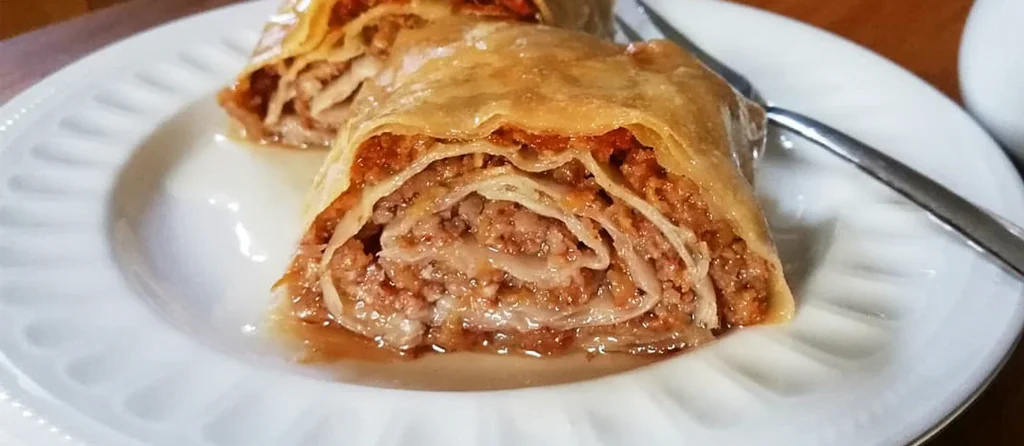
History, Background, and Region of Jabukovača in Bosnian Cuisine
Jabukovača holds a significant place in Bosnian culinary heritage, deeply rooted in the region’s rich history. Originating from the heart of Bosnia and Herzegovina, this dish reflects the cultural diversity and influences that have shaped the country over centuries.
The recipe showcases the resourcefulness of Bosnian cooking, blending flavors from Ottoman, Mediterranean, and Central European traditions.
Ingredients for Jabukovača:
- 1 kg of lean ground beef
- 500g of finely chopped onions
- 3 cloves of garlic, minced
- 2 large eggs
- 1 cup of breadcrumbs
- 1 cup of milk
- 1/2 cup of finely chopped fresh parsley
- Salt and pepper to taste
- 1 cup of vegetable oil for frying
Recipe for Jabukovača:
Preparation of Ingredients:
- In a bowl, combine the ground beef, onions, garlic, eggs, breadcrumbs, and milk.
- Add the finely chopped parsley to the mixture.
- Season the mixture with salt and pepper according to taste.
- Mix all the ingredients thoroughly until well combined.
Cooking Steps:
- Shape the mixture into oval or round patties, approximately 2 inches in diameter and 1 inch thick.
- Heat vegetable oil in a large skillet over medium heat.
- Fry the patties until they are golden brown on both sides, ensuring they are cooked through.
- Place the cooked Jabukovača on a plate lined with paper towels to absorb excess oil.
Serving:
- Serve the Jabukovača hot, accompanied by traditional Bosnian side dishes like ajvar and kajmak.
- Enjoy the flavors of this Bosnian delicacy, representing a taste of the region’s culinary history.
Serving Size: This recipe serves approximately 4 people.
Estimated Cooking Time: 45 minutes.
Calories (per serving): The estimated calorie count for one serving of Jabukovača is approximately 400 calories. Keep in mind that this is a rough estimate and may vary based on specific ingredients and portion sizes.
Bosnian Food Dish – Japrak

History and Background of Japrak
Japrak, a Bosnian culinary delight, finds its roots in the rich tapestry of Bosnian cuisine. The dish has a storied history, evolving from the crossroads of Ottoman, Mediterranean, and Central European influences.
Bosnia and Herzegovina, nestled in the heart of the Balkans, has a culinary tradition that reflects its diverse cultural heritage. Japrak, a dish featuring grape leaves stuffed with a flavorful mixture, showcases the region’s commitment to fresh, local ingredients and the art of blending different culinary legacies.
Region of Origin
The Japrak recipe has become a cherished part of Bosnian gastronomy, particularly popular in regions influenced by Ottoman culinary traditions. Its preparation varies slightly across the country, with families passing down unique twists to the recipe through generations. From the bustling streets of Sarajevo to the serene landscapes of Herzegovina, Japrak serves as a symbol of cultural unity and the joy of sharing a meal with loved ones.
Ingredients for Japrak
- Grape leaves (fresh or preserved)
- Ground beef or a blend of beef and lamb
- Rice
- Onion, finely chopped
- Garlic, minced
- Tomato paste
- Fresh parsley, chopped
- Fresh mint, chopped
- Paprika
- Salt and pepper
- Olive oil
- Lemon slices (for garnish)
Recipe for Japrak
Preparation of Ingredients
- Prepare Grape Leaves:
- If using fresh grape leaves, blanch them in boiling water for a few minutes. If using preserved leaves, rinse and soak in warm water to remove excess salt.
- Make Filling:
- In a bowl, combine ground beef, rice, chopped onion, minced garlic, tomato paste, parsley, mint, paprika, salt, and pepper. Mix thoroughly.
Cooking Steps
- Stuff Grape Leaves:
- Place a grape leaf flat on a surface. Add a small amount of the filling in the center, fold the sides, and roll tightly.
- Layer in Pot:
- Arrange the stuffed grape leaves in layers in a pot, seam side down. Place lemon slices between layers.
- Cooking:
- Drizzle olive oil over the top and add water to cover the grape leaves. Cover the pot and simmer over low heat for about 45-60 minutes, or until the rice is cooked.
- Serve:
- Once cooked, let the Japrak cool slightly before serving. Garnish with additional lemon slices and fresh herbs.
Serving Information
- Serves: 4-6 people
- Cooking Time: 1 hour (approximately)
Nutritional Information
- Calories: The calorie count will vary based on specific ingredient quantities and variations. It’s recommended to use a nutritional calculator for precise measurements.
Bosnian Food Dish – Klep
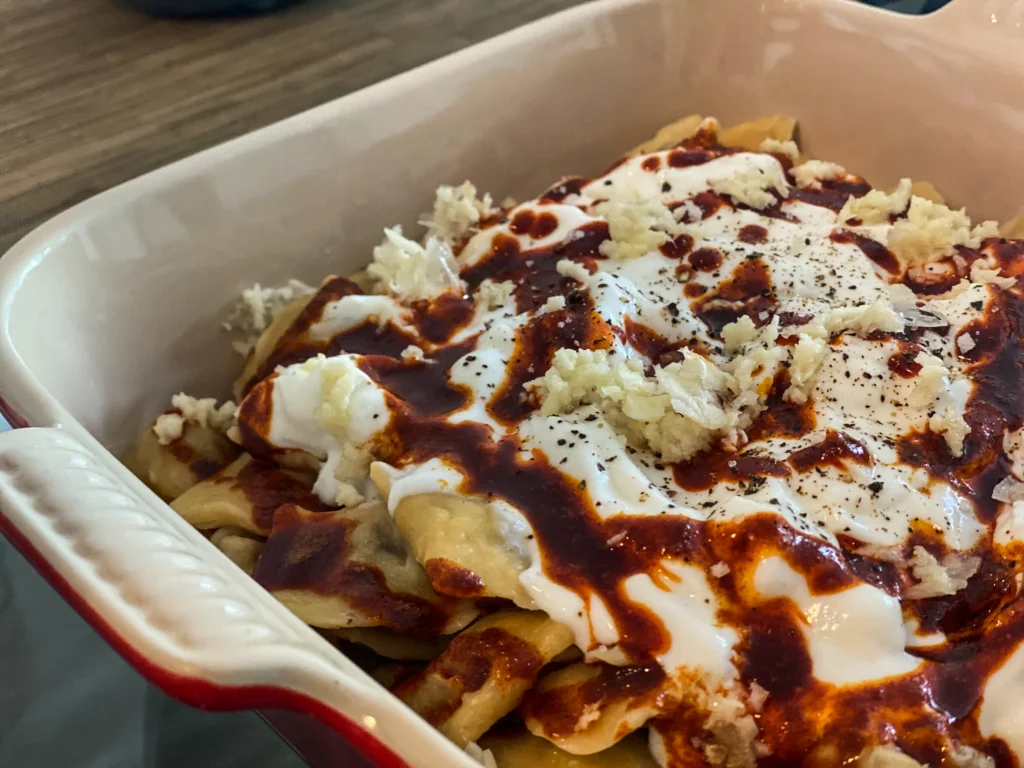
History and Background of Klepe
Klepe, a traditional Bosnian dish, carries a rich history shaped by the cultural fusion of Ottoman, Mediterranean, and Central European influences in Bosnia and Herzegovina. Originating from the Balkans, Klepe holds a special place in Bosnian culinary heritage.
The name “Klepe” reflects the local language and represents a dish that has been enjoyed for centuries. As with many Bosnian recipes, Klepe showcases the region’s commitment to fresh ingredients, hearty flavors, and the joy of communal dining.
Region of Origin
Klepe is a cherished dish across Bosnia and Herzegovina, transcending regional boundaries. Whether enjoyed in the lively streets of Sarajevo or the tranquil landscapes of Herzegovina, Klepe is a symbol of cultural unity. The dish is often prepared in homes where families gather to share their own variations, adding personal touches that make each recipe unique.
Ingredients for Bosnian Food Dish – Klepe
- Ground beef and lamb mixture
- Onions, finely chopped
- Garlic, minced
- Salt and pepper
- Paprika
- Water
- Flour
- Eggs
- Yogurt
- Baking soda
- Olive oil
- Fresh parsley, chopped (for garnish)
Recipe for Bosnian Food Dish – Klepe
Preparation of Ingredients
- Prepare Filling:
- Combine the ground beef and lamb mixture with finely chopped onions, minced garlic, salt, pepper, and paprika. Mix thoroughly.
- Make Dough:
- In a separate bowl, combine flour, eggs, yogurt, baking soda, and a pinch of salt. Knead the mixture into a soft, elastic dough.
Cooking Steps
- Forming Dumplings:
- Roll out small portions of the dough and place a spoonful of the meat mixture in the center. Fold and seal the edges to form dumplings.
- Boiling Klepe:
- Bring a pot of salted water to a boil. Gently place the Klepe dumplings into the boiling water and cook until they float to the surface.
- Drain and Serve:
- Once cooked, drain the Klepe and arrange them on a serving dish. Drizzle with olive oil and garnish with chopped fresh parsley.
Serving Information
- Serves: 4-6 people
- Cooking Time: 30-40 minutes (approximately)
Nutritional Information
- Calories: The calorie count will vary based on specific ingredient quantities and variations. It’s recommended to use a nutritional calculator for precise measurements.
Bosnian Food Dish – Krompiruša

History and Background of Krompiruša
Krompiruša, a delightful Bosnian dish, has a history rooted in the diverse culinary traditions of Bosnia and Herzegovina. The name translates to “potato pie,” and this dish showcases the region’s love for hearty, comforting food.
Drawing influences from Ottoman and Central European cuisines, Krompiruša has become a staple, especially in the colder months. Its history is deeply intertwined with the cultural fabric of Bosnia, where sharing meals with family and friends holds great significance.
Region of Origin
Krompiruša is popular across Bosnia and Herzegovina, finding its place on tables from bustling urban centers to serene rural communities. The dish is especially beloved in regions where potatoes are a staple ingredient.
Whether prepared in the cosmopolitan setting of Sarajevo or the scenic landscapes of Herzegovina, Krompiruša is a testament to the adaptability of traditional Bosnian recipes.
Ingredients for Bosnian Food Dish – Krompiruša
- Potatoes, peeled and thinly sliced
- Onions, finely chopped
- Bacon, diced
- Eggs
- Milk
- All-purpose flour
- Baking powder
- Salt and pepper
- Oil or butter (for greasing)
- Yogurt (optional, for serving)
Recipe for Bosnian Food Dish – Krompiruša
Preparation of Ingredients
- Slice Potatoes:
- Peel and thinly slice the potatoes. Pat them dry with a paper towel.
- Prepare Filling:
- In a pan, sauté finely chopped onions and diced bacon until golden brown. Set aside.
- Prepare Batter:
- In a bowl, whisk together eggs, milk, all-purpose flour, baking powder, salt, and pepper to form a smooth batter.
Cooking Steps
- Layering Potatoes:
- Grease a baking dish with oil or butter. Arrange a layer of sliced potatoes at the bottom.
- Add Filling:
- Spread the sautéed onion and bacon mixture over the potato layer.
- Repeat Layers:
- Continue layering potatoes and filling until all ingredients are used, finishing with a layer of potatoes on top.
- Pour Batter:
- Pour the prepared batter over the layered potatoes, ensuring it evenly covers the dish.
- Bake:
- Bake in a preheated oven at 180°C (350°F) for 45-60 minutes or until the top is golden brown and a knife inserted into the center comes out clean.
- Serve:
- Allow the Krompiruša to cool slightly before slicing. Serve with a dollop of yogurt if desired.
Serving Information
- Serves: 6-8 people
- Cooking Time: 45-60 minutes (approximately)
Nutritional Information
- Calories: The calorie count will vary based on specific ingredient quantities and variations. It’s recommended to use a nutritional calculator for precise measurements
Bosnian Food Dish – Krofne

History and Background of Krofne
Krofne, a beloved Bosnian pastry, boasts a history deeply ingrained in the diverse culinary heritage of Bosnia and Herzegovina. Often referred to as Bosnian doughnuts, Krofne exemplify the region’s penchant for sweet treats and indulgent delights.
The recipe’s origins are intertwined with the cultural influences of Ottoman and Central European cuisines, showcasing the fusion that defines Bosnian gastronomy. Whether enjoyed during festive occasions or as a daily indulgence, Krofne carry the warmth of Bosnian hospitality.
Region of Origin
Krofne have a place in the hearts and kitchens across Bosnia and Herzegovina, from the urban landscapes of Sarajevo to the quaint villages scattered throughout the region. The pastries hold cultural significance and are often prepared in homes where families gather to celebrate special moments.
The aroma of freshly fried Krofne is a sensory delight that transcends regional boundaries.
Ingredients for Bosnian Food Dish – Krofne
- 500g all-purpose flour
- 2 tablespoons sugar
- 1 teaspoon salt
- 10g instant yeast
- 250ml milk, lukewarm
- 3 large eggs
- 80g unsalted butter, softened
- 1 teaspoon vanilla extract
- Vegetable oil (for frying)
- Powdered sugar (for dusting)
Recipe for Bosnian Food Dish – Krofne
Preparation of Ingredients
- Activate Yeast:
- In a bowl, combine lukewarm milk, sugar, and instant yeast. Let it sit for 5-10 minutes until frothy.
- Prepare Dough:
- In a large mixing bowl, combine flour, salt, eggs, softened butter, and vanilla extract. Add the activated yeast mixture and knead until a smooth, elastic dough forms.
Cooking Steps
- Rise and Rest:
- Cover the dough and let it rise in a warm place for 1-2 hours or until it doubles in size. Punch down the dough and let it rest for an additional 15 minutes.
- Shape Krofne:
- Roll out the dough to about 1.5 cm thickness and cut out rounds using a doughnut cutter or a glass. Place the rounds on a floured surface to rise for another 15-20 minutes.
- Fry Krofne:
- Heat vegetable oil in a deep fryer or large pot to 180°C (350°F). Fry the Krofne in batches until golden brown on both sides.
- Drain and Dust:
- Place the fried Krofne on paper towels to drain excess oil. Dust with powdered sugar while still warm.
- Serve:
- Allow the Krofne to cool slightly before serving. Enjoy the sweet, fluffy goodness!
Serving Information
- Serves: 8-10 people
- Cooking Time: 2-3 hours (including rising time)
Nutritional Information
- Calories: The calorie count will vary based on specific ingredient quantities and variations. It’s recommended to use a nutritional calculator for precise measurements.
Bosnian Food Dish – Kvrguša

History and Background of Kvrguša
Kvrguša, a traditional Bosnian dish, carries with it the culinary history of Bosnia and Herzegovina. Rooted in the region’s rich cultural tapestry, Kvrguša represents the intersection of Ottoman and Central European influences in Bosnian cuisine.
This hearty dish, often referred to as a type of cornbread, has been a staple in Bosnian households for generations. The preparation of Kvrguša mirrors the essence of Bosnian cooking—simple yet deeply satisfying, reflecting the warmth of family gatherings and communal meals.
Region of Origin
Kvrguša is enjoyed across Bosnia and Herzegovina, celebrated for its versatility and comforting taste. It finds its place in both urban kitchens, such as those in Sarajevo, and rural homes scattered throughout the picturesque landscapes of Herzegovina.
The dish embodies the spirit of Bosnian hospitality, as it is frequently shared during festive occasions, family gatherings, and community events.
Ingredients for Bosnian Food Dish – Kvrguša
- 2 cups cornmeal
- 1 cup all-purpose flour
- 1 teaspoon baking powder
- 1 teaspoon salt
- 2 eggs
- 1 cup yogurt
- 1 cup milk
- 1/2 cup vegetable oil
- 1 cup feta cheese, crumbled (optional)
- Butter (for greasing)
Recipe for Bosnian Food Dish – Kvrguša
Preparation of Ingredients
- Mix Dry Ingredients:
- In a bowl, combine cornmeal, all-purpose flour, baking powder, and salt.
- Whisk Wet Ingredients:
- In a separate bowl, whisk together eggs, yogurt, milk, and vegetable oil until well combined.
Cooking Steps
- Combine Mixtures:
- Gradually add the wet ingredients to the dry ingredients, stirring continuously to form a smooth batter.
- Add Feta (Optional):
- If desired, fold in crumbled feta cheese into the batter for added flavor.
- Grease Baking Dish:
- Preheat the oven to 180°C (350°F). Grease a baking dish with butter.
- Bake Kvrguša:
- Pour the batter into the prepared baking dish and smooth the top. Bake for 30-40 minutes or until golden brown and a toothpick inserted in the center comes out clean.
- Serve:
- Allow Kvrguša to cool slightly before slicing. Serve it warm as a side dish or as a main course with yogurt.
Serving Information
- Serves: 6-8 people
- Cooking Time: 30-40 minutes (approximately)
Nutritional Information
- Calories: The calorie count will vary based on specific ingredient quantities and variations. It’s recommended to use a nutritional calculator for precise measurements.
Bosnian Food Dish – lepinja va cevapi

History and Background of Lepinja with Ćevapi
Lepinja with Ćevapi represents a cherished Bosnian culinary tradition deeply rooted in the country’s history and culture. Lepinja, a type of flatbread, has been a staple in the Balkans for centuries, and when paired with Ćevapi, small grilled minced meat sausages, it creates a quintessential Bosnian street food experience.
This dish reflects the influence of Ottoman and Central European culinary legacies on Bosnian gastronomy.
Often enjoyed in festive gatherings and social events, Lepinja with Ćevapi embodies the essence of communal dining and the conviviality of Bosnian hospitality.
Region of Origin
Lepinja with Ćevapi is popular throughout Bosnia and Herzegovina, enjoyed from the bustling streets of Sarajevo to the charming villages nestled in the country’s picturesque landscapes. The dish’s versatility and simplicity have made it a favorite across various regions, symbolizing the unity and diversity of Bosnian cuisine. Whether prepared at home or enjoyed from street vendors, Lepinja with Ćevapi has become an integral part of Bosnian culinary identity.
Ingredients for Bosnian Food Dish – lepinja
- 4 cups all-purpose flour
- 1 tablespoon sugar
- 1 teaspoon salt
- 1 packet (7g) dry yeast
- 1.5 cups warm water
- 2 tablespoons olive oil
Ingredients for Bosnian Food Dish – cevapi
- 1 pound ground beef
- 1/2 pound ground lamb
- 1 onion, finely chopped
- 2 cloves garlic, minced
- 1 teaspoon baking soda
- Salt and pepper to taste
- Chopped fresh parsley (for garnish)
Recipe for Bosnian Food Dish – lepinja
Preparation of Ingredients
- Activate Yeast:
- In a bowl, dissolve sugar in warm water, then add dry yeast. Allow it to activate for 5-10 minutes until frothy.
- Mix Dough:
- In a large bowl, combine flour and salt. Add the activated yeast mixture and olive oil. Knead until a smooth, elastic dough forms.
Cooking Steps
- Rise and Divide:
- Cover the dough and let it rise in a warm place for 1-2 hours. Divide the dough into equal portions and shape them into rounds.
- Bake Lepinja:
- Preheat the oven to 220°C (425°F). Place the dough rounds on a baking sheet and bake for 15-20 minutes or until golden brown.
Recipe for Bosnian Food Dish – lepinja va cevapi
Preparation of Ingredients
- Combine Ingredients:
- In a bowl, mix together ground beef, ground lamb, finely chopped onion, minced garlic, baking soda, salt, and pepper.
- Shape Ćevapi:
- Take portions of the mixture and shape them into small, finger-sized sausages.
Cooking Steps
- Grill Ćevapi:
- Grill the Ćevapi on a barbecue or stovetop grill over medium heat for about 10-15 minutes or until fully cooked.
- Serve:
- Slice the Lepinja, insert Ćevapi, and garnish with chopped parsley. Serve warm.
Serving Information
- Serves: 4-6 people
- Cooking Time: 1.5-2 hours (including rising time for Lepinja, and grilling time for Ćevapi)
Nutritional Information
- Calories: The calorie count will vary based on specific ingredient quantities and variations. It’s recommended to use a nutritional calculator for precise measurements.
Bosnian Food Dish – Musaka
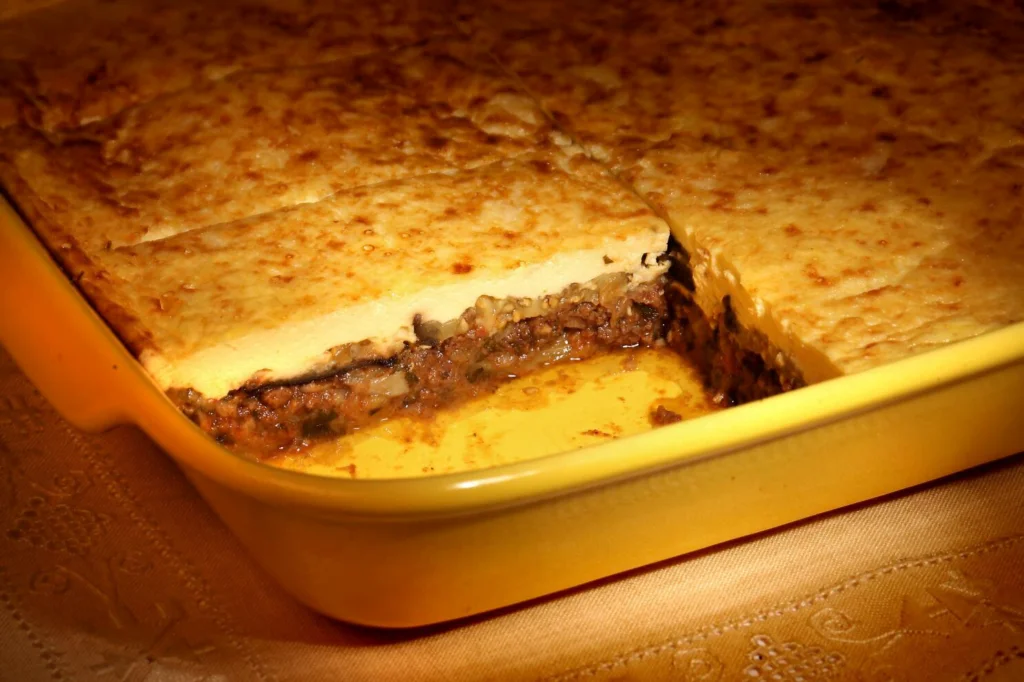
History and Background of Musaka
Musaka, a beloved Bosnian dish, carries a culinary legacy influenced by the diverse cultural heritage of Bosnia and Herzegovina. With roots in Ottoman and Central European cuisines, Musaka has evolved into a hearty comfort food, enjoyed in homes and gatherings across the region.
This layered casserole, featuring eggplant, ground meat, and a creamy bechamel sauce, reflects the historical crossroads of flavors that define Bosnian gastronomy. Musaka’s journey from the kitchens of the past to modern tables symbolizes the enduring connection between food, culture, and community.
Region of Origin
Musaka is a cherished dish throughout Bosnia and Herzegovina, transcending geographical boundaries within the country. It finds its place in urban centers like Sarajevo, where culinary traditions meet contemporary tastes, as well as in the rural landscapes where farm-fresh ingredients contribute to its authenticity.
The preparation of Musaka often varies from one household to another, with families passing down their unique twists to the recipe.
Ingredients for Bosnian Food Dish – Musaka
Meat Layer:
- 1 pound ground beef or lamb
- 1 onion, finely chopped
- 2 cloves garlic, minced
- 1 can (14 oz) crushed tomatoes
- 1 teaspoon paprika
- Salt and pepper to taste
- Olive oil for sautéing
Vegetable Layer:
- 2 large eggplants, sliced
- Salt for drawing out moisture
Bechamel Sauce:
- 4 tablespoons butter
- 4 tablespoons all-purpose flour
- 2 cups milk
- Salt, pepper, and nutmeg to taste
- 2 eggs, beaten
Recipe for Bosnian Food Dish – Musaka
Preparing the Vegetable Layer
- Slice Eggplants:
- Slice the eggplants into rounds. Sprinkle with salt and let them sit for 30 minutes to draw out excess moisture.
- Rinse and Pat Dry:
- Rinse the salted eggplants and pat them dry with paper towels.
Cooking the Meat Layer
- Sauté Onion and Garlic:
- In a pan, sauté finely chopped onion and minced garlic in olive oil until softened.
- Cook Ground Meat:
- Add ground beef or lamb to the pan and cook until browned. Drain excess fat.
- Add Tomatoes and Spices:
- Stir in crushed tomatoes, paprika, salt, and pepper. Simmer until the mixture thickens.
Assembling Musaka
- Layering:
- In a greased baking dish, layer the sliced eggplants and the cooked meat mixture.
Preparing the Bechamel Sauce
- Make Roux:
- In a saucepan, melt butter, add flour, and cook to form a roux.
- Add Milk:
- Gradually whisk in milk, stirring continuously to avoid lumps. Season with salt, pepper, and nutmeg.
- Temper Eggs:
- Gradually add beaten eggs to the sauce, tempering them to avoid curdling.
Final Steps
- Pour Bechamel Sauce:
- Pour the bechamel sauce over the layered Musaka in the baking dish.
- Bake:
- Bake in a preheated oven at 180°C (350°F) for 45-60 minutes or until golden brown.
- Serve:
- Allow Musaka to cool slightly before serving. Slice into portions and enjoy this flavorful Bosnian delight.
Serving Information
- Serves: 6-8 people
- Cooking Time: 1.5-2 hours (approximately)
Nutritional Information
- Calories: The calorie count will vary based on specific ingredient quantities and variations. It’s recommended to use a nutritional calculator for precise measurements.
Bosnian Food Dish – Peka
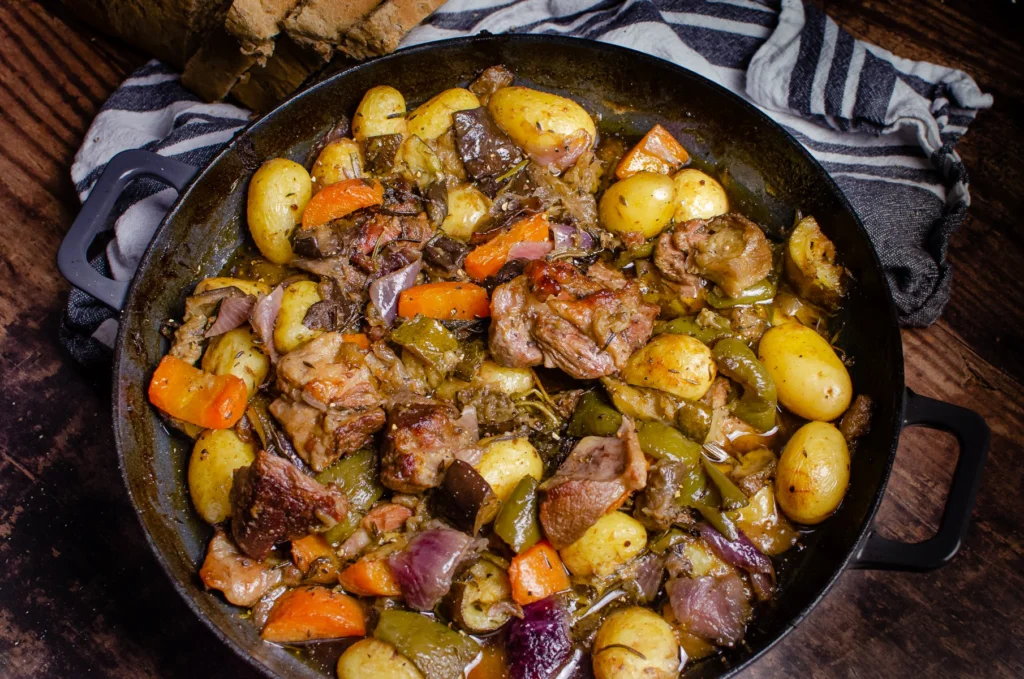
History and Background of Peka
Peka, a traditional Bosnian dish, has deep historical roots in the diverse culinary landscape of Bosnia and Herzegovina. The name “Peka” refers to both the dish and the specific method of cooking, involving slow-cooking under a metal or ceramic lid.
Originating from the region’s rural traditions, Peka represents a communal way of preparing food, often associated with festive occasions and gatherings. The slow-cooking technique allows the flavors to meld, creating a dish that captures the essence of Bosnian hospitality and the simplicity of farm-to-table cooking.
Region of Origin
Peka is closely tied to the rural areas of Bosnia and Herzegovina, where it has been a part of traditional cooking for generations. While it is enjoyed across the country, Peka is especially prominent in the mountainous regions, where it was historically prepared in outdoor hearths or communal ovens.
The dish is a reflection of the region’s agricultural abundance, utilizing locally sourced ingredients to create a hearty and flavorful meal.
Ingredients for Bosnian Food Dish – Peka
For the Meat and Vegetable Base:
- 1.5 kg lamb or beef, cubed
- 1 kg potatoes, peeled and sliced
- 500g carrots, sliced
- 2 onions, finely chopped
- 4 cloves garlic, minced
- 2 tomatoes, chopped
- 2 bell peppers, sliced
- 1 cup white wine
- 1 cup water
- 1/2 cup olive oil
- Salt, pepper, and paprika to taste
- Fresh rosemary and bay leaves for flavor
For the Peka Lid:
- Metal or ceramic lid (specifically designed for Peka cooking)
Recipe for Bosnian Food Dish – Peka
Preparing the Ingredients
- Prepare Meat and Vegetables:
- Combine the cubed meat, potatoes, carrots, onions, garlic, tomatoes, and bell peppers in a large mixing bowl.
Assembling Peka
- Layering:
- In a deep baking dish or a Peka pot, layer the mixed meat and vegetables. Season each layer with salt, pepper, and paprika. Add fresh rosemary and bay leaves for flavor.
- Pour Liquids:
- Pour white wine and water over the layered meat and vegetables. Drizzle olive oil on top.
Cooking Peka
- Covering with the Lid:
- Place the Peka lid over the ingredients, ensuring a tight seal to trap steam.
- Outdoor Cooking:
- Traditionally, Peka is cooked outdoors, either in an open hearth or on hot coals. The cooking time can vary but typically takes 2-3 hours.
- Indoor Cooking: Preheat the oven to 180°C (350°F) and bake with the lid on for approximately 2-3 hours.
Final Steps
- Check Doneness:
- After the cooking time, carefully remove the Peka lid and check the doneness of the meat and vegetables. They should be tender and flavorful.
- Serve:
- Serve the Peka directly from the pot, letting everyone enjoy the rich flavors and aromas.
Serving Information
- Serves: 6-8 people
- Cooking Time: 2-3 hours (approximately)
Nutritional Information
- Calories: The calorie count will vary based on specific ingredient quantities and variations. It’s recommended to use a nutritional calculator for precise measurements.
Bosnian Food Dish – Pljeskavica
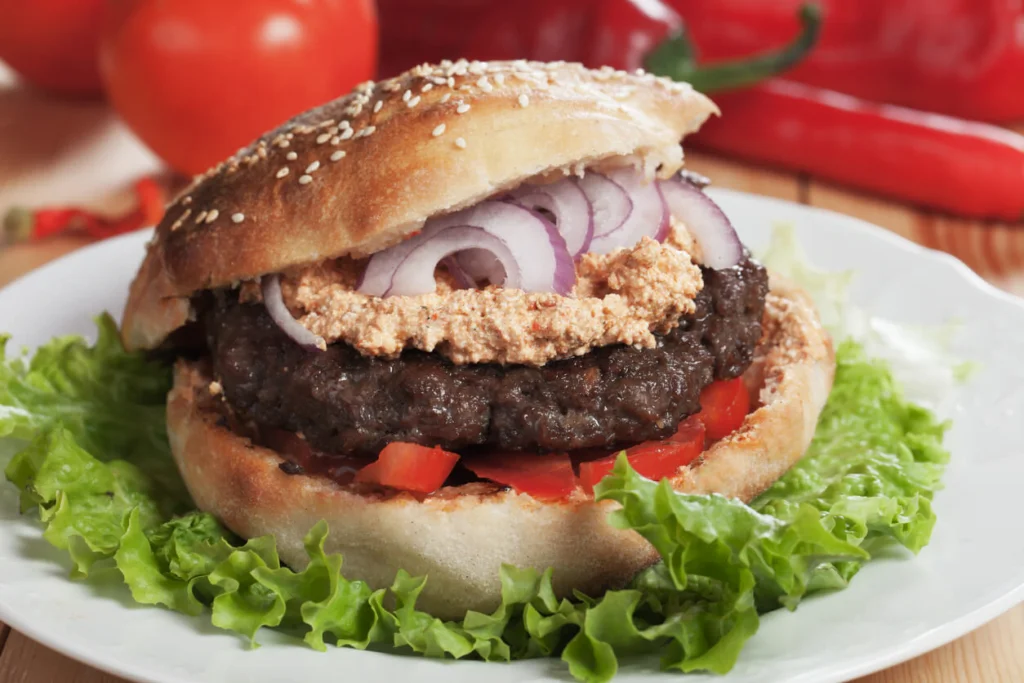
History and Background of Pljeskavica
Pljeskavica, a beloved Bosnian dish, traces its roots to the rich culinary heritage of the Balkans. Originating from the Ottoman era, this grilled dish has become an integral part of Bosnian gastronomy.
Pljeskavica is a seasoned and grilled ground meat patty, often served in a flatbread or as part of a larger meal. It embodies the cultural fusion that characterizes Bosnian cuisine, combining influences from Ottoman, Mediterranean, and Central European traditions. Whether enjoyed as street food or a family meal, Pljeskavica reflects the heartiness and conviviality of Bosnian dining.
Region of Origin
Pljeskavica is popular across Bosnia and Herzegovina, and its preparation may vary slightly from region to region. The dish is celebrated in both urban and rural settings, symbolizing the diversity and unity of Bosnian culinary traditions.
Grilled to perfection, Pljeskavica captures the essence of warm summer evenings, lively gatherings, and the joy of sharing a delicious meal with family and friends.
Ingredients for Bosnian Food Dish – Pljeskavica
- 500g ground beef
- 250g ground pork
- 1 onion, finely chopped
- 2 cloves garlic, minced
- 1 egg
- 2 tablespoons breadcrumbs
- 1 teaspoon paprika
- Salt and pepper to taste
- Vegetables for garnish (tomato, lettuce, onion)
- Flatbread or burger buns
Recipe for Bosnian Food Dish – Pljeskavica
Preparing the Meat Mixture
- Combine Ground Meat:
- In a large mixing bowl, combine ground beef and ground pork.
- Add Aromatics:
- Mix in finely chopped onion, minced garlic, and an egg for binding.
- Seasoning:
- Add breadcrumbs, paprika, salt, and pepper for flavor. Mix the ingredients thoroughly.
Forming and Grilling Pljeskavica
- Shape Patties:
- Divide the meat mixture into equal portions and shape them into round, flat patties.
- Preheat Grill or Pan:
- Preheat an outdoor grill or a stovetop grill pan over medium-high heat.
- Grill Pljeskavica:
- Grill the patties for approximately 4-5 minutes on each side, or until they reach the desired level of doneness.
Assembling Pljeskavica
- Prepare Garnishes:
- Slice tomatoes, lettuce, and onions for garnish.
- Serve in Flatbread or Burger Buns:
- Place the grilled Pljeskavica in flatbread or burger buns.
- Garnish and Enjoy:
- Add your choice of vegetables, condiments, and garnishes. Serve immediately.
Serving Information
- Serves: 4 people
- Cooking Time: 15-20 minutes (approximately)
Nutritional Information
- Calories: The calorie count will vary based on specific ingredient quantities and variations. It’s recommended to use a nutritional calculator for precise measurements.
Bosnian Food Dish – Prebranac

History and Background of Prebranac
Prebranac, a traditional Bosnian dish, holds a significant place in the country’s culinary heritage. Its origins are deeply rooted in the Ottoman and Balkan traditions that have shaped Bosnian gastronomy. The name “Prebranac” translates to “pre-soaked beans,” highlighting the central ingredient of this hearty dish.
Prebranac is a flavorful and comforting casserole made with beans, onions, and a medley of spices. Often enjoyed as a main course or a side dish, Prebranac reflects the simplicity and heartiness that characterizes Bosnian home cooking.
Region of Origin
Prebranac is a dish commonly prepared and savored throughout Bosnia and Herzegovina. It epitomizes the essence of Balkan cuisine and has become a staple in both rural households and urban kitchens.
The dish is frequently enjoyed during family gatherings, festive occasions, and as a delicious way to showcase the versatility of beans—a key ingredient in Bosnian cooking.
Ingredients for Prebranac
- 500g white beans (cannellini or navy beans)
- 2 large onions, finely chopped
- 2 cloves garlic, minced
- 1/2 cup vegetable oil
- 1 tablespoon paprika
- Salt and pepper to taste
- 2 bay leaves
- Water for soaking and cooking
Recipe for Prebranac
Preparing the Beans
- Soak Beans:
- Rinse the beans thoroughly and soak them in water overnight or for at least 8 hours.
- Cook Beans:
- Drain the soaked beans, place them in a pot, cover with fresh water, and simmer until they are tender. This can take 1-2 hours depending on the type of beans.
Cooking Prebranac
- Preheat Oven:
- Preheat the oven to 180°C (350°F).
- Sauté Onions and Garlic:
- In a large ovenproof dish, sauté finely chopped onions and minced garlic in vegetable oil until softened.
- Add Paprika and Seasonings:
- Stir in paprika, salt, and pepper. Add bay leaves for extra flavor.
- Mix with Cooked Beans:
- Mix the cooked and drained beans with the sautéed onion mixture, ensuring the beans are well-coated with the seasoned oil.
- Bake:
- Place the dish in the preheated oven and bake for 30-40 minutes or until the top forms a golden crust.
Serving Information
- Serves: 4-6 people
- Cooking Time: 2-3 hours (including bean soaking and cooking time)
Nutritional Information
- Calories: The calorie count will vary based on specific ingredient quantities and variations. It’s recommended to use a nutritional calculator for precise measurements.
Bosnian Food Dish – Proha

History and Background of Proha
Proha, a classic Bosnian dish, embodies the culinary traditions of Bosnia and Herzegovina, showcasing the country’s rich cultural and historical influences. This savory pie has deep roots in the Ottoman and Central European culinary heritage, where the inventive use of simple ingredients creates a dish that is both comforting and flavorful.
Proha’s popularity extends beyond borders, reflecting the enduring appeal of Balkan cuisine. Whether enjoyed as a part of daily meals or served on special occasions, Proha encapsulates the essence of Bosnian home cooking and the warmth of shared family recipes.
Region of Origin
Proha is a staple in Bosnian households across the entire region, from urban centers to rural communities. It is a versatile dish that finds its way onto tables for various occasions, offering a delicious combination of simplicity and taste. The recipe’s adaptability has allowed it to become a cherished part of Bosnian gastronomy, representing a crossroads of flavors that define the country’s diverse culinary landscape.
Ingredients for Bosnian Food Dish – Proha
- 3 cups all-purpose flour
- 1 cup plain yogurt
- 1 cup milk
- 3 eggs
- 1/2 cup vegetable oil
- 200g feta cheese, crumbled
- 100g butter, melted
- 1 teaspoon baking powder
- Salt to taste
- Sesame seeds or nigella seeds for topping (optional)
Recipe for Bosnian Food Dish – Proha
Preparing the Batter
- Combine Dry Ingredients:
- In a large bowl, mix all-purpose flour, baking powder, and a pinch of salt.
- Whisk Wet Ingredients:
- In a separate bowl, whisk together yogurt, milk, eggs, and vegetable oil until well combined.
- Create Batter:
- Slowly incorporate the wet ingredients into the dry ingredients, stirring continuously to form a smooth batter.
Assembling Proha
- Add Feta Cheese:
- Gently fold in crumbled feta cheese into the batter, ensuring an even distribution.
- Grease Baking Dish:
- Preheat the oven to 180°C (350°F). Grease a baking dish with butter.
- Pour Batter:
- Pour the batter into the prepared baking dish, spreading it evenly.
Baking Proha
- Bake:
- Bake in the preheated oven for approximately 30-40 minutes or until the top is golden brown and a toothpick inserted into the center comes out clean.
- Brush with Butter:
- As soon as Proha is out of the oven, brush the top with melted butter for a glossy finish.
- Optional Topping:
- Sprinkle sesame seeds or nigella seeds on top if desired.
Serving Information
- Serves: 6-8 people
- Cooking Time: 30-40 minutes (approximately)
Nutritional Information
- Calories: The calorie count will vary based on specific ingredient quantities and variations. It’s recommended to use a nutritional calculator for precise measurements.
Bosnian Food Dish – Pura s lučinicom
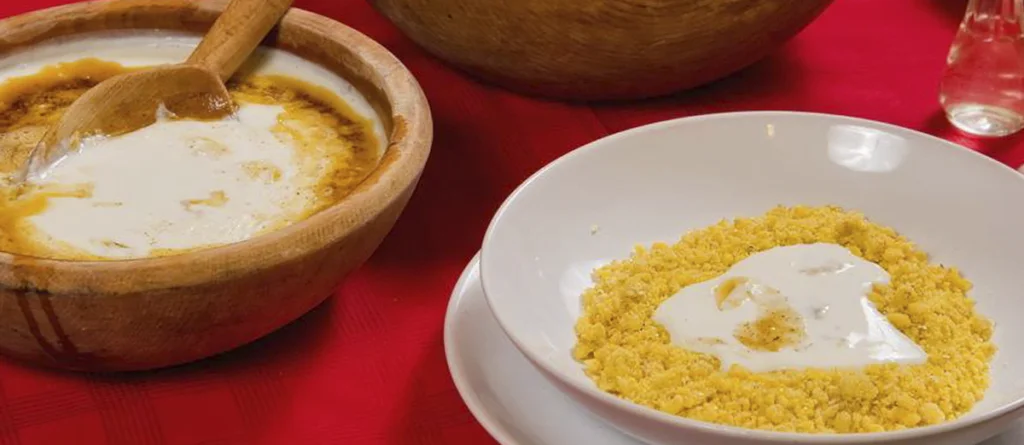
History and Background of Pura s Lučinicom
Pura s Lučinicom, a traditional Bosnian dish, reflects the culinary heritage of Bosnia and Herzegovina, deeply rooted in the country’s history and cultural influences. This dish, often enjoyed as a hearty meal, combines simplicity with rich flavors.
The name “Pura s Lučinicom” translates to “pura with wild chicory,” showcasing the use of locally sourced and foraged ingredients. The dish captures the essence of Bosnian cuisine, where the use of fresh, seasonal produce and inventive cooking methods highlight the region’s diverse and flavorful offerings.
Region of Origin
Pura s Lučinicom is popular across Bosnia and Herzegovina, particularly in the rural areas where wild chicory grows abundantly. It is a dish that brings people together, often enjoyed in family settings or during communal gatherings.
The use of wild chicory adds a distinctive touch, connecting the dish to the natural landscapes and traditions of the region.
Ingredients for Pura s Lučinicom
- 1 kg potatoes, peeled and sliced
- 500g wild chicory (lučinica), washed and chopped
- 1 onion, finely chopped
- 3 cloves garlic, minced
- 4 tablespoons vegetable oil
- 200g smoked meat (bacon or smoked sausage), diced
- Salt and pepper to taste
- Water for cooking
Recipe for Pura s Lučinicom
Preparing the Ingredients
- Prepare Potatoes:
- Peel and slice the potatoes into rounds.
- Chop Wild Chicory:
- Wash and chop the wild chicory (lučinica).
Cooking Pura s Lučinicom
- Sauté Onion and Garlic:
- In a large pot, sauté finely chopped onion and minced garlic in vegetable oil until softened.
- Add Smoked Meat:
- Add diced smoked meat (bacon or smoked sausage) to the pot and cook until it releases its flavor.
- Layer Potatoes and Chicory:
- Layer sliced potatoes and chopped wild chicory in the pot, alternating between the two.
- Season:
- Season each layer with salt and pepper.
- Add Water:
- Pour enough water into the pot to cover the layered ingredients.
Cooking Process
- Simmer:
- Simmer the mixture over medium heat until the potatoes are tender and the flavors meld. This may take approximately 30-40 minutes.
Serving Information
- Serves: 4-6 people
- Cooking Time: 30-40 minutes (approximately)
Nutritional Information
- Calories: The calorie count will vary based on specific ingredient quantities and variations. It’s recommended to use a nutritional calculator for precise measurements.
Bosnian Food Dish – Ružice

History and Background of Ružice
Ružice, a delightful Bosnian pastry, has a history deeply intertwined with the country’s rich culinary traditions. The name “Ružice” translates to “little roses,” aptly describing the delicate and intricate shape of these pastries.
Originating from the Ottoman era, Ružice reflects the influence of Turkish and Middle Eastern flavors on Bosnian cuisine. Often enjoyed during festive occasions, Ružice are not only a delicious treat but also a symbol of hospitality and celebration in Bosnia and Herzegovina.
Region of Origin
Ružice are a beloved dessert throughout Bosnia and Herzegovina, enjoyed in both urban centers and rural communities. The pastry’s popularity transcends regions, making it a common sight on dessert tables across the country.
The preparation of Ružice is a cherished tradition passed down through generations, highlighting the cultural significance of these sweet delights.
Ingredients for Bosnian Food Dish – Ružice
Dough:
- 4 cups all-purpose flour
- 1 cup warm milk
- 1/2 cup vegetable oil
- 2 tablespoons sugar
- 1 packet (7g) dry yeast
- Pinch of salt
Filling:
- 1 cup ground walnuts
- 1/2 cup sugar
- 1 teaspoon ground cinnamon
- Zest of one lemon
- 1/2 cup milk (for brushing)
Syrup:
- 1 cup water
- 1 cup sugar
- Juice of one lemon
Recipe for Bosnian Food Dish – Ružice
Making the Dough
- Activate Yeast:
- In a bowl, dissolve sugar in warm milk and add dry yeast. Let it sit for 5-10 minutes until frothy.
- Mix Ingredients:
- In a large bowl, combine the activated yeast mixture with flour, vegetable oil, and a pinch of salt. Knead until a smooth dough forms.
Preparing the Filling
- Mix Filling Ingredients:
- In a separate bowl, mix ground walnuts, sugar, ground cinnamon, and lemon zest to create the filling.
Assembling Ružice
- Roll Out Dough:
- Roll out the dough into a thin rectangle on a floured surface.
- Spread Filling:
- Spread the walnut filling evenly over the rolled-out dough.
- Roll into a Log:
- Carefully roll the dough into a log, creating a spiral pattern with the walnut filling.
- Cut into Pieces:
- Cut the rolled dough into smaller pieces, each resembling a little rose.
- Place on Baking Sheet:
- Arrange the cut pieces on a baking sheet lined with parchment paper.
Baking Ružice
- Preheat Oven:
- Preheat the oven to 180°C (350°F).
- Brush with Milk:
- Brush each Ružica with milk for a golden finish.
- Bake:
- Bake in the preheated oven for 20-25 minutes or until the pastries are golden brown.
Making the Syrup
- Prepare Syrup:
- In a saucepan, combine water, sugar, and lemon juice. Simmer until the sugar dissolves and a syrup forms.
Final Steps
- Pour Syrup:
- Pour the warm syrup over the baked Ružice as soon as they come out of the oven.
- Serve:
- Allow the Ružice to soak in the syrup and cool slightly before serving.
Serving Information
- Serves: 8-10 people
- Cooking Time: 20-25 minutes (approximately)
Nutritional Information
- Calories: The calorie count will vary based on specific ingredient quantities and variations. It’s recommended to use a nutritional calculator for precise measurements.
Bosnian Food Dish – Rostilj

History and Background of Rostilj
Rostilj, meaning “grill” in Bosnian, is a culinary tradition deeply rooted in the culture of Bosnia and Herzegovina. Influenced by the Ottoman and Mediterranean culinary heritage, Rostilj has become a symbol of communal dining and celebration.
Whether enjoyed at family gatherings, social events, or as street food, Rostilj represents the heart and soul of Bosnian outdoor cooking. This grilling tradition embraces a variety of meats, creating a flavorful and aromatic experience that captures the essence of Bosnian gastronomy.
Region of Origin
Rostilj is a popular practice throughout Bosnia and Herzegovina, enjoyed across the country’s diverse landscapes. Whether in the bustling streets of Sarajevo, the serene villages, or during countryside celebrations,
Rostilj is a unifying element in Bosnian cuisine. The grilling culture thrives in the warm summer months, creating an inviting atmosphere for friends and family to gather around the grill and savor the delicious aromas.
Ingredients for Rostilj
Marinade:
- 1/2 cup olive oil
- 1/4 cup red wine vinegar
- 3 cloves garlic, minced
- 1 teaspoon paprika
- 1 teaspoon dried oregano
- Salt and pepper to taste
Meat:
- 1 kg mixed meats (beef, lamb, pork, chicken), cut into skewer-friendly pieces
- Sausages and kebabs for variety
Serving:
- Freshly baked somun or pita bread
- Chopped onions
- Ajvar (red pepper and eggplant relish)
- Kajmak (clotted cream)
Recipe for Rostilj
Preparing the Marinade
- Mix Marinade Ingredients:
- In a bowl, combine olive oil, red wine vinegar, minced garlic, paprika, dried oregano, salt, and pepper to create the marinade.
- Marinate the Meat:
- Place the mixed meats in a large bowl and coat them thoroughly with the prepared marinade. Cover and refrigerate for at least 2 hours, or overnight for enhanced flavor.
Grilling Rostilj
- Preheat the Grill:
- Preheat the grill to medium-high heat.
- Skewer the Meat:
- Thread the marinated meat onto skewers, alternating with sausages and kebabs for variety.
- Grill the Meat:
- Grill the skewers on the preheated grill, turning occasionally, until the meat is cooked to your desired level of doneness. This usually takes 15-20 minutes.
Serving Rostilj
- Prepare Bread and Condiments:
- Warm the somun or pita bread. Arrange chopped onions, ajvar, and kajmak for serving.
- Serve Hot:
- Serve the grilled meat skewers hot, allowing everyone to assemble their own sandwiches with the bread and condiments.
Serving Information
- Serves: 4-6 people
- Cooking Time: 15-20 minutes (grilling time)
Nutritional Information
- Calories: The calorie count will vary based on the specific types and quantities of meat used. It’s recommended to use a nutritional calculator for precise measurements.
Bosnian Food Dish – Sir iz mijeha

History and Background of Sir iz Mijeha
Sir iz Mijeha, a distinctive Bosnian dish, has its roots deeply embedded in the country’s rural culinary traditions. Translating to “cheese from a sheep’s stomach,” this dish represents the resourcefulness of Bosnian cuisine, where simple ingredients are transformed into a flavorful delicacy.
Traditionally made in rural households, Sir iz Mijeha reflects the pastoral lifestyle of Bosnia and Herzegovina, where dairy products hold a special place in the daily diet. This unique cheese-making process is a testament to the country’s rich agricultural heritage.
Region of Origin
Sir iz Mijeha is particularly associated with the rural areas of Bosnia and Herzegovina, where sheep farming is prevalent. The dish showcases the connection between the local population and their livestock, emphasizing the sustainable and traditional aspects of Bosnian gastronomy.
It is a dish that exemplifies the essence of farm-to-table practices in the region.
Ingredients for Sir iz Mijeha
- Sheep’s stomach (mehur)
- Sheep’s milk
- Salt
- Water
Recipe for Sir iz Mijeha
Preparing the Sheep’s Stomach
- Clean and Soak Stomach:
- Thoroughly clean the sheep’s stomach, removing any excess fat or residue. Soak it in cold water for several hours to ensure cleanliness.
Making the Cheese
- Heat Sheep’s Milk:
- In a large pot, heat sheep’s milk over low to medium heat. Avoid boiling; the goal is to heat it gently.
- Add Salt:
- Once the milk is warm, add salt to taste. Stir the milk to dissolve the salt evenly.
- Fill the Stomach:
- Carefully pour the salted milk into the prepared sheep’s stomach, filling it to the desired quantity.
- Secure the Stomach:
- Tie the sheep’s stomach securely with kitchen twine, ensuring that the milk is contained within.
- Simmer in Water:
- Fill a larger pot with water and bring it to a simmer. Immerse the tied sheep’s stomach in the simmering water.
Cooking Process
- Simmer Until Set:
- Allow the sheep’s stomach to simmer in the water for an extended period, typically 4 to 6 hours. This slow cooking process allows the cheese to set.
- Cool and Solidify:
- Once cooked, remove the sheep’s stomach from the water and allow it to cool. As it cools, the cheese inside will solidify.
Serving Information
- Serves: The quantity will depend on the size of the sheep’s stomach and the desired thickness of the cheese.
- Cooking Time: 4-6 hours (simmering time)
Nutritional Information
- Calories: The calorie count will vary based on the size of the sheep’s stomach and the amount of milk used. It’s recommended to use a nutritional calculator for precise measurements.
Conclusion
In conclusion, the culinary landscape of Bosnia and Herzegovina is as diverse and rich as the cultural tapestry that defines this beautiful country. From hearty traditional dishes like cevapi and burek to delicate pastries and sweet delights, Bosnian cuisine offers a tantalizing journey for the taste buds.
Throughout history, Bosnian cuisine has been shaped by influences from the Ottoman Empire, Austro-Hungarian rule, and neighboring regions, resulting in a unique fusion of flavors and culinary traditions. Each dish tells a story of resilience, adaptation, and the enduring spirit of the Bosnian people.
As you savor the aromatic spices, sizzling meats, and freshly baked breads of Bosnia and Herzegovina, you’re not just indulging in food—you’re experiencing a cultural heritage passed down through generations. So whether you’re exploring the bustling streets of Sarajevo or dining in a cozy village tavern, take a moment to savor the flavors and appreciate the rich culinary heritage of this enchanting country.
Commonly Asked Questions
How is Bosnian cuisine influenced by its diverse history?
Bosnian cuisine is a melting pot of diverse influences shaped by centuries of history. The country’s geographic location at the crossroads of the Ottoman and Austro-Hungarian Empires has left a profound impact on its culinary traditions.
Turkish, Middle Eastern, and Mediterranean flavors blend with Central European elements, creating a unique and varied gastronomic experience. This fusion is evident in the use of spices, meats, and techniques that characterize Bosnian cuisine.
What are some staple ingredients in Bosnian cooking?
Staple ingredients in Bosnian cooking include a variety of meats such as beef, lamb, and poultry, often prepared through grilling or slow cooking. Additionally, grains like rice and bulgur, legumes, dairy products, and fresh vegetables play a crucial role.
The use of flavorful spices, herbs, and condiments like paprika, garlic, and ajvar adds depth and richness to many dishes.
Can you explain the significance of traditional Bosnian dishes in daily life?
Traditional Bosnian dishes hold a deep significance in daily life, serving as a reflection of cultural identity and shared heritage. These dishes often bring families and communities together during celebrations, religious holidays, and social gatherings.
They not only provide sustenance but also create a sense of connection and continuity, passing down flavors and recipes through generations.
How does Bosnian cuisine vary across regions?
Bosnian cuisine exhibits regional variations influenced by local geography, climate, and cultural preferences. In urban areas, you may find a broader range of international influences, while rural regions often preserve more traditional recipes.
Coastal areas feature seafood prominently, while mountainous regions showcase hearty meat-based dishes. Each region contributes its unique twist to the overall tapestry of Bosnian cuisine.
What is the significance of coffee in Bosnian culture?
Coffee holds a special place in Bosnian culture, signifying hospitality, socializing, and leisure. Bosnian coffee, prepared using a distinct method similar to Turkish coffee, is served in small cups accompanied by lively conversations.
The coffee-drinking ritual is a cherished tradition, fostering connections and providing a break from daily routines.
How do Bosnians typically celebrate special occasions through food?
Special occasions in Bosnia are celebrated with elaborate feasts featuring a variety of dishes. Cevapi, dolma, and baklava are commonly served during festive gatherings.
Roasted meats, savory pies, and traditional sweets take center stage, symbolizing abundance, generosity, and the joy of communal festivities.
Can you recommend a traditional Bosnian Food dish for someone new to the cuisine?
For someone new to Bosnian cuisine, I recommend trying cevapi.
These small, grilled minced meat sausages, usually served with somun (flatbread), diced onions, and a red pepper-based condiment called ajvar, offer a delicious introduction to the rich flavors and grilling traditions of Bosnian cooking.

